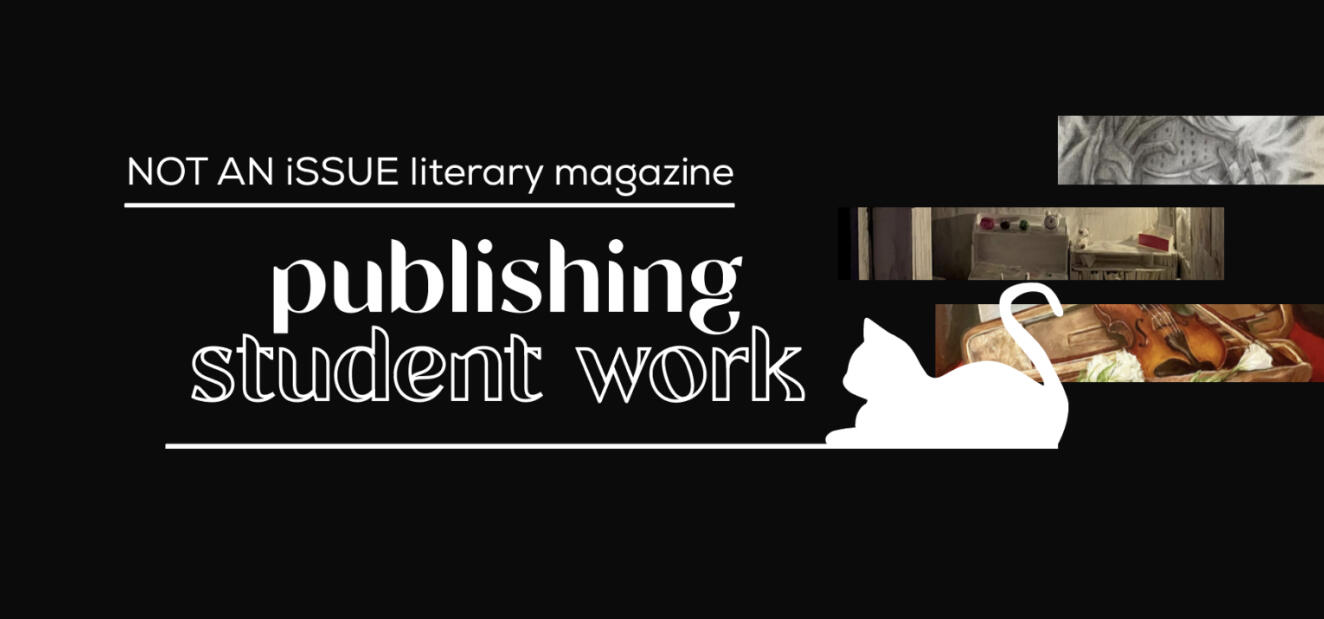
NOT AN iSSUE is a space made for creative exploration. Started by a team of young, passionate creators, we're a place where writers, artists, and readers can connect and feel welcome. Our goal is to make publishing accessible and to offer a platform for anyone who wants to share their story.Here, every story matters—whether it’s about love, resilience, or anything else you want to express. NOT AN iSSUE is all about building a creative community where young voices and underrepresented perspectives have a place to shine. We want to be a welcoming destination for creators who care about sharing and growing together.
Get involved with NOT AN iSSUE!
Submissions
In general, NAi has pretty loose rules regarding submissions, but we do ask that you read the ones listed below to avoid any extra hassle; thank you!We aim to offer publication to as many young artists as possible as long as the piece fits within the story of each issue, so please feel free to submit! Every artist will receive personalized feedback on the work they submit, regardless of acceptance status.
Theme
Submissions are currently closed, but submissions for our next issue, which will be focused on photography, will be open soon! Make sure to keep an eye on our Instagram as we post updates on this! Also, our blog submissions are open, so make sure to check that out! Submit To Our Blog Here!Typically, issues will have a theme that submissions should relate to in some way. In addition to following the theme, submissions will typically have to follow the eligibility requirements below.
Eligibility
All youth ages 14-22 are welcome to submit their work. NAi reserves the right to be selective. We aim to publish creative works with meaningful intent!
Types of Work Accepted
Fiction (Short Story)
Flash Fiction
Novel Writing (please only submit an excerpt)
Poetry
Dramatic Script
Creative Nonfiction
Memoir
Design (including fashion)
Comic Art
Digital Art
3-D Sculpture
Painting
Illustration
Photography
Masthead
Editorial Board
Sneha Moudgalya
Editor in Chief
Isabelle Charernruengkit
Social Media Lead
Sumana Sri Manikala
Executive Editor
Zara Azeem
Senior Editor
Vienna Chen
Graphic Design Lead
Editors
Elaine Shiao
Editor
Ayushi Paul Roy
Editor
Palomi
Editor
Designers
Emily
Graphic Designer
Taslym Umar
Graphic Designer
Public Relations
Jelany
Social Media Team
Cioara
Social Media Team
Web Design
Sasi
Web Manager and Designer
Adrita
Writer
Finance
Saiah Campomanes
Financial Team Manager
Zidan Mallick
Financial Team
Blog
Kpop Artists: Art or Artist? The Rise in Parasocial Relationships Controlling the K-pop Industry
By: Isabelle
"One news article reported, 'Seunghan from Riize went on hiatus after pre-debut photos of him kissing a woman were leaked.' Another soon followed: 'Funeral wreaths sent to Riize’s headquarters protesting Seunghan’s return to the group.'"
Interview With Calum Burton: Part 2
By: NAi Staff
It’s interesting, because I find it harder to write when I try to use a certain prompt from a lit mag, and when I’m specifically writing for a submission to a magazine. I’ve been doing that recently and I definitely feel it’s harder because if you write from what you’re experiencing, you can make it however you want to make it, and you can edit it however you want to, whereas with specific prompts, it’s definitely more challenging and, in a way, it’s more fun because of that.
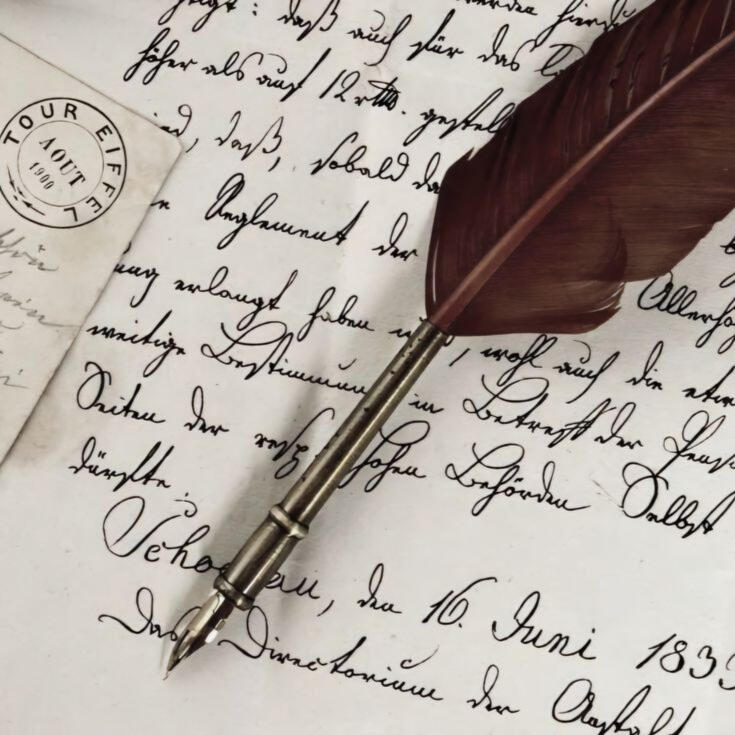

Interview With Calum Burton: Part 1
By: NAi Staff
When you read a book, it’s structured so well, and it can be daunting to dip your toes into that sector of it, so when I started to read more in my last few years of school before going to uni, I had this story in my mind for a good few years - I’m pretty sure it was what I used to daydream about - it just gave me comfort, a lot of the time. I started to write poems that I thought were really bad - like 3am, nonstop poetry - and when I started to write, I didn’t put any limitations on myself. It felt like I knew, when I started out, that it wasn’t good. I think that’s the main thing people need to know when they really dive in, that we think about writing more than actually writing.
Inspiration vs. Copycatting
By: Sasi
Pretty much every writer draws inspiration from somewhere, whether it be events in their life, their feelings (which is the source of most of my writing), or other writers. While drawing inspiration from other writers is natural, it’s important to make sure that this inspiration doesn’t turn into simply copying the original author’s work. How do you know whether your work is an inspiration or a copy, though?


The Birth of the Womb
By: Natalie Gachoka
Who was She? The sea, the storm that carried my birth? The Earth that cradled me from the moment my feet first touched Her soil? I could no longer tell where I ended and the bloom began, our bodies entwined, indistinguishable—like roots weaving into each other, one form growing into the next. But there was comfort in that union.
5 Tricks I’ve Used To Overcome My Writer’s Block
(And You Can Too)!
By: Sasi
If you’ve ever written, you’ve likely experienced writer’s block - that feeling where you don’t know what to write. It can make you want to crumple up your story or hit “delete” on that poem you’ve written on Google Docs, but it's important to not give up and instead try finding ways to get back into the right mindset! We’ve come up with a few tips (that I have used in the past whenever I was stuck on a piece) for you to help you overcome writer’s block and get those creative juices flowing again!


The History And Accomplishments of NAi
By: Sasi
You may have seen us on social media or submitted to an issue, and you may be wondering who exactly we are. Not An iSSUE, also known as NAi, is a literary magazine dedicated to providing an opportunity for students to be published and show their talents! We have accomplished quite a bit since we began, like releasing several magazine issues, starting up a blog, and gaining an international staff. How did we get to this point, though? This article will serve as a recap of how NAi has started, what NAi has accomplished, and our future plans!
What To Do Before Submitting A Piece For Publication Part 2: The Submission Process
By: Sasi
After writing a piece, it may feel like there’s no other work to do with submitting a piece for publication, which can make it seem tempting to simply submit the article. However, it is important that you are editing your piece and carefully following the submission process to make sure that you’re giving yourself the best chance to be accepted.


What To Do Before Submitting A Piece For Publication Part 1: The Editing
By: Sasi
When you finish writing a piece, it can feel very tempting to go ahead and click the submission button or hit send on an email to get your work over to a publication. However, once you finish writing a piece, you still have some work to do!
Interview with Viyomiarts
"What got you into drawing in the first place?"In elementary school I really honed into it with my best friend for our class newspaper at the time. We also watched so many art YouTubers (Mark Crilley, etc.) and really loved the anime drawing style, and we always inspired each other to keep drawing and making cool things.
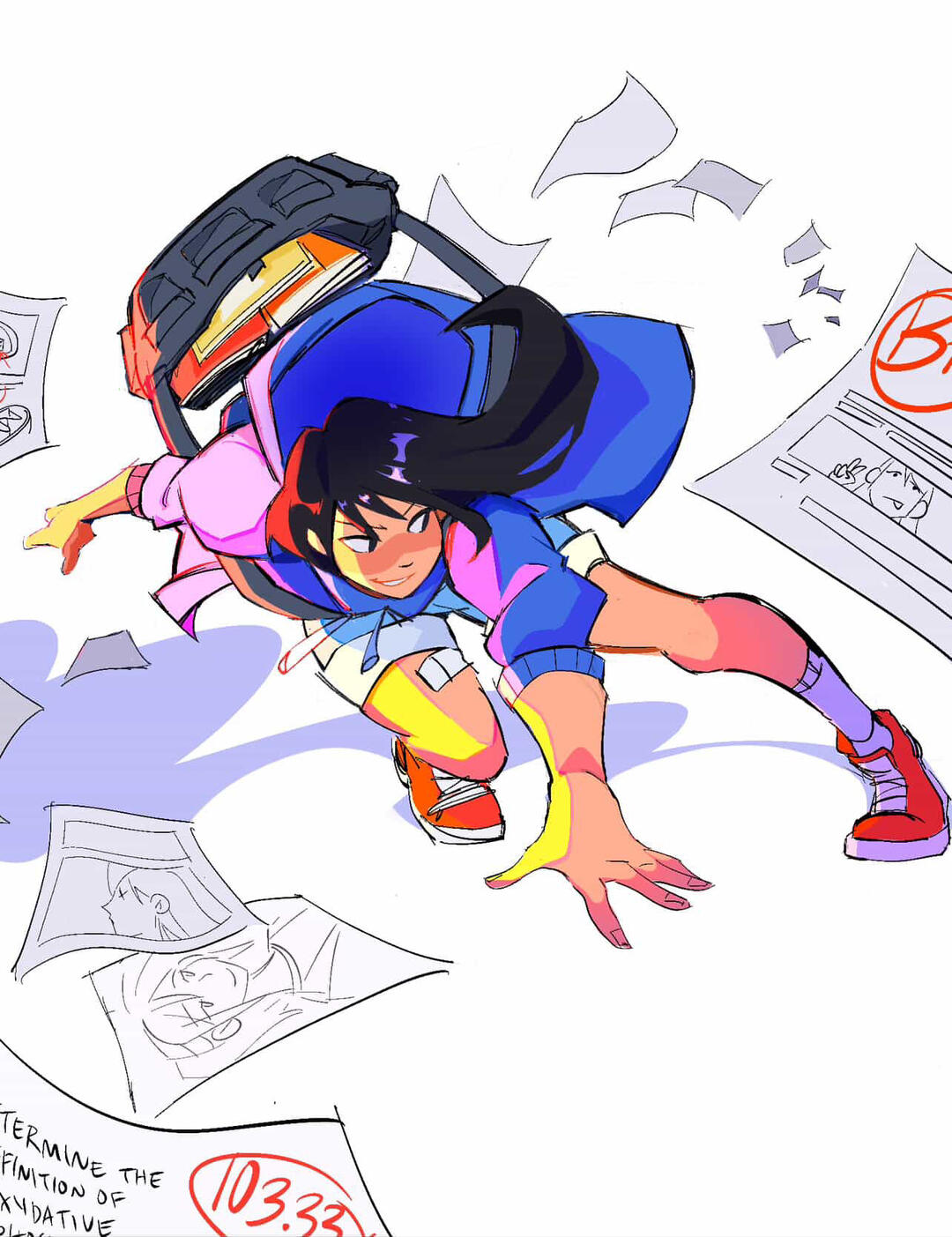
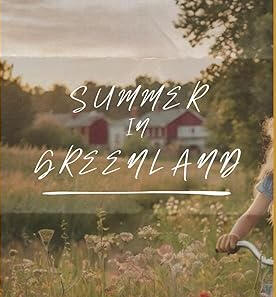
Book Review: Summer in Greenland — A Lyrical Ode to Youth, First Love, and Fleeting Time
Book by: Chainka
Book Review by: LunetteSummer in Greenland has an unquestionably nostalgic and captivating quality to it, capturing the essence of growing up rather than simply chronicling a boy's summer vacation. At first sight, it appears to be a calm story about a young teen's seasonal trip, but by the end, you'll feel as if you've relived your own childhood through the warm cloud of dandelion dust and youthful idealism.
Interview with Brianna
"What inspired you to create Spring is Coming? Was there a specific moment or memory behind the concept?"When I found out the prompt was like bloom, I wrote out a list of what bloom meant to me and what I wanted to incorporate into that piece. Then after I wrote out a list I made little thumbnails. I made a bunch of thumbnails and then I picked my favorite one that I wanted to show the most; I wanted to incorporate a bunny. I wanted to incorporate flowers and so I thought a fun way to do that was to have the bunnies be underground.

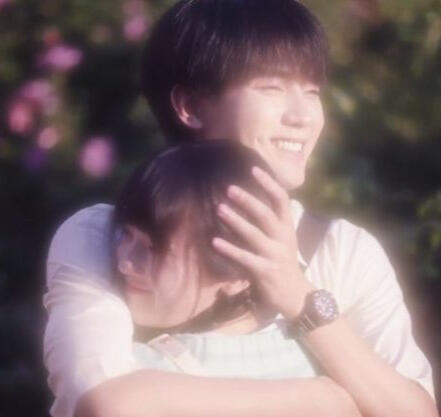
WIFTY (Rang Rang)
By: Isabelle
“Before I met you, I only lived to keep the name, Zhang Lurang alive, but after meeting you, I was excited for tomorrow to come” -Zhang Lurang. When I Fly Towards You (WIFTY)
Princess Mononoke Movie Review
By: Anya
Princess Mononoke is a Japanese animated historical fantasy film by Studio Ghibli that explores the importance of nature, and the dangers of hatred. Set in a mythical past, the story follows Ashitaka, a young Emishi prince cursed by a demon, who seeks a cure and becomes caught in a violent conflict between Irontown; a small industrial town, and the forest gods.

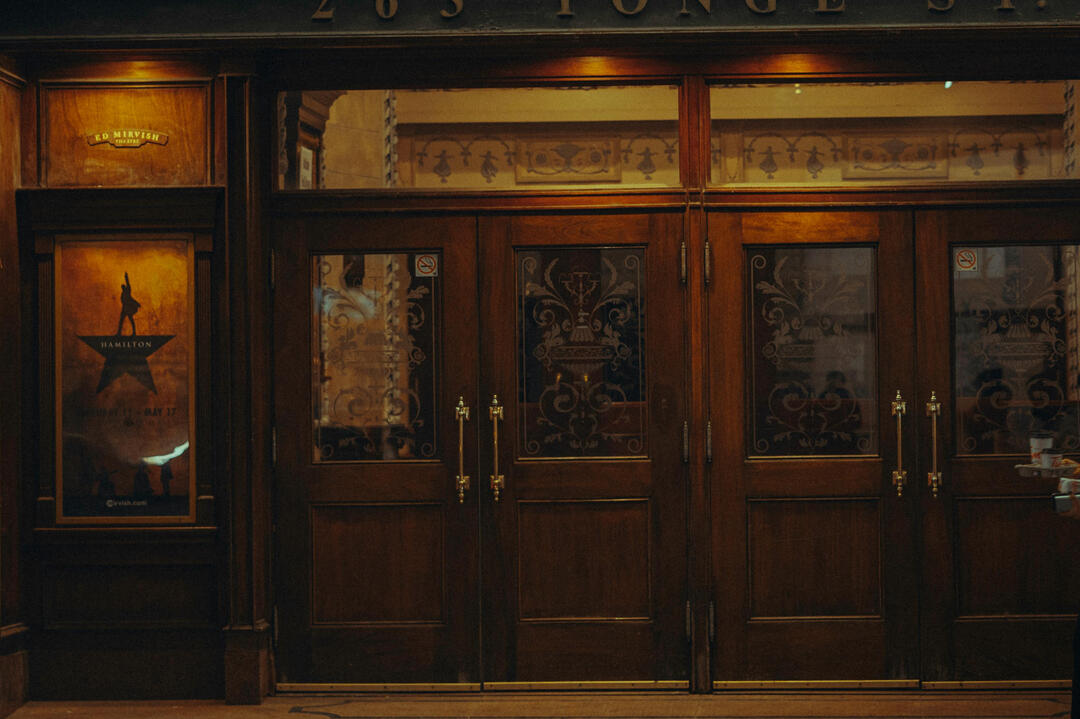
Threshold
By: Vanessa S.
The air is thick with dying gold,
the trees like specters bow and weep.
A hush, a hush, the branches moan,
as autumn lulls the world to sleep.
Fate
By: Diana
How can a lover feel like a stranger
We’re so close yet it feels like
An ocean is between us
Who’s that?
Nobody


Winter Book Recommendations
It’s that time of the year again when we all snuggle up in our cozy blankets, drink hot chocolate, and wait for the soft snowflakes to land. However, there is no true winter without books! Where are some of our favorite winter stories to snuggle up with and escape this winter, as the world grows dark.
Interview with Mehul Chowdhary
"What inspired you to create Through Dragon Gate?"In elementary school, I used to be into legends. I came across the legend of the dragon, the Chinese legend and how the car jumped through the water, falling into the gate; for me at the time, it was really cool because I hadn't ever read something like this. Then, when I looked back at it in high school, I realized that I could use it to represent how people can overcome their hardships. And it was the only creative idea I had at the time, so I just decided to try it.
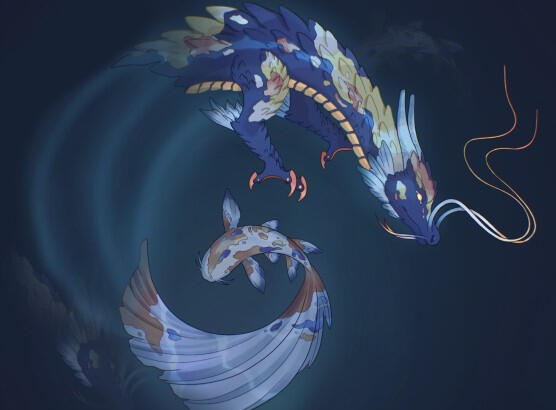

Interview with Chainka
"What inspired you to create the portrait of a girl in the apple garden?”It's hard to pick just one thing. I was actually thinking about The Portrait of Dorian Gray, the book which I read a long time ago. This piece is kind of dedicated to my friend, but also to me in some ways, and all the girls that have been through it because, you know, we never know what will be in adulthood. And we always wait for something beautiful to happen.
Book Review: Addie Larue
By: Sneha Moudgalya
For someone who’s been alive for over two centuries, Addie LaRue doesn’t have many friends. In fact, there isn’t anyone who remembers her, really. Addie has stumbled through almost 300 years of life with no one to talk to, or rely on, with her biggest goal being to leave a mark on the world; but it never really works. That is, until a boy recognizes her at a tiny bookstore, opening a whole new chapter in her dazzling adventure.


Percy Jackson TV Show Review
By: Zara Azeem
The new Percy Jackson and the Olympians series on Disney+ is the newest adaptation of the beloved Percy Jackson and the Olympians book series. So far, only one season depicting the first book has been released. Will the series live up to the fans’ standards of the original series, or will it fail like the myriad of previous adaptations before it?
Internships for Students
10 activities. All 10 of them should be related to your ”intended major” while at the same time showing you have “passions.” College applications have been getting more competitive by the year.
Several activities, like internships, can help you fill those 10 spaces. However, can they fulfill you and provide an enjoyable and worthwhile experience? Now, that’s something to ask yourself.


Young Writers – an interview with Apuroopa Kavikondala
By: Catherine Xue
Learn more about this exciting young writer and her work!
For those unfamiliar with Apuroopa, she is a junior in high school that has published four books, one of her most recent releases being Us AF, a story which follows three main protagonists as they navigate the final years of their high school life. Outside of being a published author, she’s a dancer, martial artist and a social animal that aspires to make an impact and highlight the gravity of mental health.
Kpop Artists: Art or Artist? The Rise in Parasocial Relationships Controlling the K-pop Industry
By: Isabelle

One news article reported, “Seunghan from Riize went on hiatus after pre-debut photos of him kissing a woman were leaked.” Another soon followed: “Funeral wreaths sent to Riize’s headquarters protesting Seunghan’s return to the group.”Three days after Seunghan’s return, he was permanently kicked out of the group–due to obsessive fans' discontent about the fact that he was dating before becoming a K-pop artist. Fans in Asia believed that this was a reasonable reaction; however, fans overseas saw it as obsessive and unfair.Parasocial Relationships in K-pop
According to a clinical psychologist at Cleveland Clinic, Adam Borland, PsyD, describes parasocial relationships as “one-sided relationships or bonds with people you don’t know.” This may be a character from a novel, or most often, celebrities, such as K-pop idols. In most cases, it’s harmless, as fans recognize that they don’t know the celebrity and the celebrity doesn’t know them. However, in special cases, such as Riize’s fans in Asia, they live in the fantasy that because they’re dedicating their time and money to the idols, the idols now belong to them. Due to the fact that these “fans” contribute the most in overall revenue, idols are required to abide by the fans’ wishes. For instance, male idols aren’t allowed to touch, make eye contact, or have choreographs with female idols, as it can lead to dating rumors, destroying the fans’ belief that one day, they would be able to date the idols.How K-pop Feeds on Parasocial Relationships
Through these past few years, technology has been advancing rapidly– from having to go to the library for research or buy cassette tapes to listen to music to being able to get all of that through the click of a smartphone. This advancement made it possible for fans to spend every waking minute consuming content about their idol and being up to date with the whereabouts and schedule of that idol.
Today, K-pop agencies have created paid mobile apps that feed on the fans’ parasocial relationships with the idols, such as Bubble or Weverse. According to Lillian Yang, a former research assistant with Nielsen Norman Group, “[Bubble and Weverse] stimulate private messaging between idols and fans, [allowing them to] feel as though they’re receiving a private message written just for them.” Through these paid “conversations” with the idols, it created this belief that fans know everything there is to know about their idol, as idols often update fans about their day-to-day life on these platforms. Not only do these platforms feel as though the fans and the idols are best friends, but the inclusion of live streams allows fans to connect with the idols in real time, further strengthening their emotional attachment to the idols.Harms of Being in Parasocial Relationships
Though the parasocial relationship was first formed as a way to fulfill psychological needs such as the need for belonging and validation, as it gets more intense, it can start to interfere with the fans’ daily lives.
With how easy it is to follow up on the idols, fans deeply attached to their idols would feel the need to check what the idol is doing multiple times a day, negatively impacting their focus. As a result, it can take the fan longer to finish schoolwork or chores as they constantly feel the need to check on the idol.
In addition to that, it can affect how the fan forms authentic friendships outside of their parasocial lives. Due to how absorbed the fans are in their parasocial relationship, they might start to ignore their friendships in order to go to an idol’s events or wait outside the building the idol is in to catch a glimpse of them walking out. In addition to this, when an idol is caught in a dating rumor, the fan would spend thousands of dollars to send a protest truck to the door of the idol’s company with a billboard that read along the lines of “is the love given by the fans not enough for you” or even start to boycott the idol’s works until they break up.Conclusion
K-pop companies use the fans’ parasocial relationships with the idols as profit through the use of paid apps, building a sense of intimacy between the idol and the fan. This dynamic blurs the lines between fantasy and reality, leading to obsessive behaviors and unrealistic standards set for the idols by fans, as seen through Riize’s Seunghan’s situation. Ultimately, this dynamic can harm not only the idol who endures immense pressure and loses control of their lives as a result of fans’ behaviors, but also the fans, whose real-life relationships and routines can be lost.Links:
https://www.nngroup.com/articles/kpop-private-messaging/
https://health.clevelandclinic.org/parasocial-relationships
Inspiration vs. Copycatting
By: Sasi

Oh my god, this book is amazing! We totally have to publish it! It reminds me of my favorite book series, like with the plot and the characters and the setting…wait a minute, it’s the exact same thing. We can’t publish this - it’s basically a copy!Pretty much every writer draws inspiration from somewhere, whether it be events in their life, their feelings (which is the source of most of my writing), or other writers. While drawing inspiration from other writers is natural, it’s important to make sure that this inspiration doesn’t turn into simply copying the original author’s work. How do you know whether your work is an inspiration or a copy, though?First of all, you should be able to distinguish your piece and the other piece from each other. This isn’t just referring to the names of characters and settings. There should be something that makes your piece stand out from the other. Perhaps the themes are the same, but your work has a different take on them. Maybe both pieces are built off of similar premises, but their plots diverge.Whatever the similarities and differences may be, your piece should have something that makes it truly unique from other similar works. If your work and other works that you got inspiration from were side-by-side, yours shouldn’t look like a ripoff of the other one (minor references that wouldn’t break any copyright guidelines are okay though). Your work shouldn’t sound like “[name of work you got inspired from] 2.0”. Whatever the differences are, they should be noticeable to you and your readers.This means that other people should be able to tell the difference as well. Consider showing your piece to friends and family, especially those who are already familiar with other similar works, and express your concerns to them. They may help reassure you that your work isn’t a copy or help you come up with ways to distinguish your piece from other similar works.If you find yourself wanting to start over when you feel like your work may be in the copying territory, that’s okay! Just make sure to follow the advice above first if you’d like to check if your work just draws inspiration first. It’s important that when you create a piece, it remains original. Remember, every writer has something unique to share, and that uniqueness is what people want to read.
Interview With Calum Burton: Part 2
By: NAi Staff

Do you have any rituals or habits that help you get into a creative mindset before writing?It’s interesting, because I find it harder to write when I try to use a certain prompt from a lit mag, and when I’m specifically writing for a submission to a magazine. I’ve been doing that recently and I definitely feel it’s harder because if you write from what you’re experiencing, you can make it however you want to make it, and you can edit it however you want to, whereas with specific prompts, it’s definitely more challenging and, in a way, it’s more fun because of that.As for my own rituals, I like to read before writing. I feel like every single person says that, but especially in this day and age, I tend to doomscroll a lot, and then I don’t get anything done. Even with reading, sometimes I’ll doomscroll and then I’ll get annoyed because I haven’t done any reading. But I do think my day is better when I force myself to read in the morning after I’ve gotten ready, and once I’ve read a chapter or two - depending on how long the chapters are - I’ll settle down and think about what I’m going to write. I feel like it’s harder to sit down at my desk and think “Ok, let’s think of an idea.” If I already have an idea, I can build upon it, and I think reading is a massive way I do that.I also get inspired by certain pieces. Or I’ll think of a short story from a conversation with a friend, and that’s how I’ll get an idea.What role does feedback play in your writing process, and how do you handle criticism?If I’m honest, I’m not a feedback-y person. It’s probably an issue I have, because I’m quite scared of feedback from other writers, because I know other people in your sector of interest are going to be brutal, and it’s definitely something I’m not keen on.If I’m asking for feedback to improve, I think that’s when I get scared. Especially with my stories, I don’t like changing it; especially if it’s a certain part and like, my soul is connected to that part, I’m not changing that part. I feel like that’s the type of author I’ll be in the future, but hopefully that’ll change. I do want to go to writing workshops to get feedback, because I feel like that’s something no one likes, but you have to do. But I really don’t like it, it’s my least favorite part.Are there particular themes or topics you’re passionate about exploring through your writing?The most obvious one in my writings is probably queer love, because I feel the intricacies and patterns in it are so different from heteronormative love. I read this story with queer love and queer joy in a teenager, in school, and I think in writings, when it has a teenager in it being introspective and learning about the world around them, I think that’s quite important.A lot of my writings stem from past experiences of childhood, when I used to live with my mum. In childhood there’s definitely a gauze wrapped around how you remember a certain period of your childhood. That was the inspiration for a lot of my early poetry and how I write full pieces. It’s embedded in my mother and family life then.I think a few full pieces of mine are just spur of the moment. I do want to write more “weird” stuff.What advice would you give to other student writers who want to improve but struggle with motivation or time management?A big issue I had when I started to write more creatively, and I loved it - it was this honeymoon phase where I couldn’t go wrong, because I wasn’t looking at anyone else’s writing and I wasn't comparing myself. But when I started uni, I had this almost mini-crashout because I began wondering whether what I was studying was right for me. I’m not sure if writers have this same dilemma of, “I love writing, but I have to do this for more practical reasons.” Because for writing, you can’t just jump into it and get paid straight away. It’s a process - a lot of renowned authors get their recognition when they’re gone fifty or something.My advice, in terms of writing and motivation, would be don’t force it; don’t put pressure on yourself to always be writing constantly. I know when I’m off on my summer break, I’m not going to be writing every week - I’m going to have to actively think about and search for art to jog that creative mind a bit, for when I do have spare time. One thing I will say is if you commute to work or wherever you need to go, if you’re a reader, read a book or a magazine. Even if it’s poetry or an art book, that’s so important. If you have time as well, go to art galleries, art museums, even if it’s by yourself. Because when you go back to school, uni, college, whatever it is, it’s easy to get caught up in the whole chaos of it all. You start thinking about what other people think of you, in my case, how to get the work done, and there’s a lit mag you want to submit to and the deadline’s coming up and the maximum number of pieces you can put through is three and you haven’t written one. For motivation, just do what you need to do - prioritize, but that’s not to say don’t write. Even reading other people’s writing is being creative, and don’t be hard on yourself if what you produce isn’t the best, because it takes time and you can always edit literally anything.For spare time, see if you can steal a few minutes. If you feel like writing something, there’s this journaling method where you can blurt out what you’re thinking - if you’re thinking of an apple, write about an apple named whatever. Or write about your week, but switch up the names of the people. You can write about anything, but if you’re writing, you’re writing. I think that’s the main point. But if you’re exhausted from uni and stuff, it’s ok to take a break. If you’re too exhausted to read, that’s good too.Anything else you want to share with our readers about yourself, your writing, or writing in general?I think when you’re young, it’s nice to write whatever, but I don’t think we should feel like we have to write a certain piece. That’s why I want to explore different genres, because even though I like to write in a literary fiction sort of way, I also at some point want to write a story - I don’t even know if it’s going to be a short story or a novel. But I’ve been really interested in super powers - it sounds really childish, but I find superpowers and mutants really cool. My brother used to always try to get me into Marvel, or Superman, or Batman, but I’m more into the mutation side. I want to write something with a group of late teens in that unfamiliar stage of life, and there’s this apocalyptic breakout of mutations, and they’re one of them. There’s this clash of politics as well. There’s definitely a lot more thinking that has to go into it, but I watched a few movies of the X-Men and that inspired the idea.There are so many things I want to write about, but I also don’t always write something if I’m inspired by it. I’ve been watching the Hunger Games recently and I’m absolutely obsessed, but I just find it so interesting how it’s done, and the names, the politics, the love story, the rebellion and everything, it’s just amazing.
Interview With Calum Burton: Part 1
By: NAi Staff

What inspired you to start writing, and how has your relationship with writing evolved over time?I didn’t always want to write. I thought it was this academic thing where people who write creatively are people who are in that kind of school environment, in that kind of courtification; like if you’re studying English or you want to be an author, whereas a lot of creative writing is unlimited. You can do whatever you feel like with it.When you read a book, it’s structured so well, and it can be daunting to dip your toes into that sector of it, so when I started to read more in my last few years of school before going to uni, I had this story in my mind for a good few years - I’m pretty sure it was what I used to daydream about - it just gave me comfort, a lot of the time. I started to write poems that I thought were really bad - like 3am, nonstop poetry - and when I started to write, I didn’t put any limitations on myself. It felt like I knew, when I started out, that it wasn’t good. I think that’s the main thing people need to know when they really dive in, that we think about writing more than actually writing.So when I started writing this story, I started it years ago and scrapped it maybe three or four times. I think that’s a big thing, not just with author-type or commercial writing, but with prose and poetry - it can be imperfect, it can be whatever you want it to be, and I’ve definitely realized that when writing more poetry.How do you balance writing for different audiences, like your Substack readers versus school assignments?With the assignments I get at uni, because I”m studying psychology, a lot of it essay based, so it’s definitely hard - it’s almost like a withdrawal symptom, like when you write academically, then you have free time - like a week when you haven’t got many assignments, or you have to look at the articles you need to write these assignments - then I’ll think, “I can sneak a bit of creative writing into my own spare time,” and it does take me some time to get back to my creative mind.When I speak to my parents about it, I say, “I have two minds. One in my formal style because of the lecturers and teachers that say, “We don’t want any of that flowery language,” so with the skills and techniques, even whilst I’m studying, I’ve had to read, transgressive stuff mainly, like I like to read poetry on the train because I feel like with poetry, it’s often very much out of the box and subversive, and that definitely helps me to jog and stretch my mind when I take my spare time to creative write or whatever comes to mind.How do you stay motivated to write consistently, especially when schoolwork and other responsibilities pile up?It’s actually quite a big struggle because before the whole “getting the spare time” and trying to get back into the rhythm of writing, you’ve actually got to find that spare time to write, and when you do have that spare time, you’re doing more writing than what you’re doing for your academics. I think we definitely put pressure on ourselves to be like, “why haven’t I written anything?” and then you look at your previous work and you’re like, “why isn’t the work I’m producing as good as I did?” I think we start to blame our own lives, but I think it comes when it comes.Then again, I feel like it’s quite reductive and simplistic to just say, “it comes when it does.” If I’m honest, I don’t think I can give very good advice for it because with my uni, it is quite lenient and I do have time where I can say, “right at this time, I’m going to stop doing academic work.” So I do think there’s a kind of balance we need to have with our creative and social lives, as well as with our academic lives.Sometimes it’s in the evening, or maybe it’s random prompts I’ll have. It’s really just out of the blue - tomorrow I might write something that today, I couldn’t tell you I’m going to do. But I think mostly, it is poetry that I tend to write whilst I’m at uni. I’m not sure why, I think it’s because it’s more spur of the moment. If the moment’s passed, it’s quite odd to capture it again.Can you share your writing process? For example, how do you approach brainstorming, drafting, and revising?I’m not sure I have a set process I go by - it’s quite messy, if I’m honest. Sometimes, when I’m writing a poem, there’ll be only a few tabs open, because I am quite guilty of having tabs open that are just like, “what does this word mean?” or “synonyms for this word,” because I don’t study English and I’m not always exposed to loads of different, flowery words. So I’ve always got a thesaurus by my side or on my desk or something.But in terms of my writing process, it’s quite messy. Sometimes I’ll write things during the day in my Notes app, or I’ll go out to a coffee shop and bring a physical notebook and write or continue a story I’ve been writing, and I’ll then copy that into my google doc or something. But that is quite time consuming, so I don’t do that all the time.A lot of times, my drafting process is writing things from spur-of-the-moment. I think I deliberately make it deliberately messy, because when I see things I’m like, “Oh my god that’s so ugly, I don’t like how that looks at all” but I have to remind myself that I haven’t even edited it. I saw a quote the other day on Substack where it said something on the line of, “you can’t edit a black page, but you can edit and add to a few words or a feeling.” I just try to replay that through my mind when I’m drafting something.My editing process is mainly reminding myself and asking myself the question of, “have I captured this moment as best as I can?” Going through what I’ve written, especially with my prose pieces now, I try to see if I can make the structure a bit different, and with my poetry pieces, I try to remind myself that I can repeat lines. I tend to forget that, and I feel like it becomes simplistic, or what I’m trying to capture is too complex and people are going to think, “what the hell does this mean?”My last, final touches would probably be making sure the consistencies align. With poems and prose pieces, by the end I’ve reread it so many times. Then I’ll send it over to a magazine, or publish it on my substack, or sometimes I’ll just leave it there for a while and think, “I’ll come back to you.”How do you find and develop your unique voice and style in your writing?It’s interesting to hear that from you, because I still feel like a newbie at this, even though it’s been like a few years. I asked a similar thing to this guy I went on a date with a few days ago. He’s a writer as well, like a screenwriter, and he was talking a lot about his writing process. And I asked him, “what do you think makes a voice? How does someone find a writer voice?” He was saying, it’s the small intricacies of what happens through each piece a writer has. If you see a piece by a writer, you can find a pattern of characters, or storylines, or if they have a similar protagonist, et cetera.I agree, kind of, but I slightly disagree. I think it’s hard when someone gives you a critique saying, “You don’t have a unique voice. You need to develop a voice and make it seem particular.” I feel like that’s such a difficult critique, because how do you even go about that?I personally believe, the more you write, the more you’re developing your voice. The more you experiment and consume more art - not deliberately, but naturally. I find it difficult to develop that voice, because I don’t actively seek to develop it sometimes. When I write, I sometimes think, “Is this really me, or am I just chucking in a bunch of words that don’t really mean much or regurgitating a lot of little things?”Ultimately, I couldn’t really tell you, to be honest. I think if I go form my short stories, I naturally tend to go for similar characters, writing from the perspective of characters who are minimally flawed; like people who are sensitive on the inside, but that doesn’t get translated to real life. I think I just like to make my writing soft, in a way, because that’s how I see myself, and I think, especially in the state of this world currently, I feel like, If I’m actively trying to put a voice accross, i want it to be soft but not in a placid way. I feel like when people think of gentleness, they think they can’t partake in activism but I feel like they can, and that’s what literature is made for.
The Birth of the Womb
By: Natalie Gachoka

It started with a cough lodged between my breaths, stuffing my throat and pressing against my lungs like water drowning bubbles. It was a pain that grew into a beast that could no longer be contained, a feral need to break free from its cage. For days on end, the sickness would expand, and each day, it would be a struggle. I would cough again, again, and again. Each time, sharper—a knife cushioned by the edge of my ribs, sculpting my bones into art. I sought out the wisdom of men, but doctors said it was nothing. My pain was a delusion I concocted in the haze of dreariness. They could not see the pain I was experiencing, as they had no notion of anything beyond the ideas of man’s medicine. So I let it fester within me, a dormant sickness that seemingly had no cure. The beach became my comfort, where sand tears met the edge of the Earth, and the sky bent into the sea like a prayer. The foam of the tide whispered howls of love. I would walk on the pier, the waves becoming one with me. The air shimmered with something not quite wind. The waves pulled toward me like hands. On the eve of its birth, on my strolls spectating the seagulls mate with the sun, the seed of the cough sprouted, a single petal, pale yellow and soft as silk. It was streaked with blood and lace. An excruciating battle commenced within my body, every inch of me recoiling in the fight. I was being rewritten from the inside. The core of my being was fracturing under the weight of the invasion within me. It was not just my body; it was my soul, every breath, every heartbeat, resisting. My body writhed as the root tore through my flesh. My blood was the soil that fed the bloom, devouring me from the inside out until my very organs pulsed with their hunger. The roots spread with merciless purpose, forcing their way out, carrying the scent of a sickly perfume— a rot disguised as nectar. Was this a curse? A prophecy? A rebirth? I did not know. Only that it would not relent. The flower had transformed me—its roots were my intestines, leaves my veins, petals my voice. I tried to scream, clawing at my skin. I tried to peel the bark away from my skin, but the more I grasped, the more my flesh dissolved—oozing, sloughing off in ribbons. My vision became blurred with golden spores. The roots crept upwards, threading through the hollows of my skull, bursting through my sinuses, coiling around my jaw, claiming every hollow space as their own. I thrashed on the beach; the sand crawled towards me, drowning my feet in grain. I felt like a sinner being punished for the sin of man. I prayed, denied, raged. I wept at any foot that would answer my prayer. "What did I deserve the pain? Do I need to become a faithful servant of the wind?" I asked the sky. "Will you spare me if I bow low enough?" The tide licked at my feet like a loyal animal. I watched the sun shatter into the ocean and wondered if it hurt to sink. A melodic hum vibrated between my ribs. I was losing hold of my body; it was transforming into Her instrument, any note to be played by whim. My pulse felt foreign as a symphony played through my bones. I was being orchestrated by Her—the Mother, the Earth’s conductor, guiding me to Her will. I screamed. I dug into the roots and yanked at them with trembling hands. I tried burning them with salt water, stabbing them with driftwood, and biting at the vines as they slipped up my throat. "Whoever you are? Whatever you are, leave me be." The wind laughed at my plight. My muscles trembled in resistance. My skin blistered where Her bloom pressed near the surface. I spit petals into the sand. Who was She? The sea, the storm that carried my birth? The Earth that cradled me from the moment my feet first touched Her soil? I could no longer tell where I ended and the bloom began, our bodies entwined, indistinguishable—like roots weaving into each other, one form growing into the next. But there was comfort in that union. Was this what She had destined me to be—tethered to Her whims, kneeling at Her mercy, a servant bowed to the curve of Her knee? She caressed the slick of my womb, ready to be opened to release the budding flower, nurtured from the river of my tears. She had cast the curse, waiting for me to beg Her to undo it, to free me from the very thing that called me to Her. I had fought Her with everything I had with teeth, pleas, and prayer. There was terror in her embrace, yes, but there was also warm stillness. She was remaking my body of clay and mud into a sacred relic. “Why do I fight you?” I spoke to Her.
“Because as a child, you still believe pain is punishment. But this is creation.”
"Who are you?"
"You are the beginning and the end, the milk of the breast you suck on?"
"You're God?"
She laughed as if a child had asked an ignorant question
"You can not see past the need for a god and worship, but some have called me a god. Some of my past friends have called me Mother as I nurture your air. Though recently, the hubris of man has forgotten me, rotting my body."
"So why have I been barred to pay the sins of man?"
"You are not meant to repent for their misgiving but be their revelation”.
“What am I to you?”
I breathed in Her scent and let it root in my lungs. My rage no longer roared. It sighed.
“You are my seed. My storm. My becoming.” And with those words, something inside me broke—then healed. Like a dam giving way not to flood, but to cleanse. Was She not the force that shaped us all—the dark womb of creation and destruction? She was both the end and the beginning, the soil and the storm, the cradle and the grave. I closed my eyes, trying to steady my racing pulse, but there was no escaping Her. She had consumed my mind, and all that remained was the rasp of Her nails against the ridges of my brain. “Come with me,” was all the drums of my heart said to me. Who was I to ignore what my body thrummed for? I craved Her, and She craved me just the same. “Why am I suddenly at your mercy? Do you hold me in the palm of your hand to embrace or to claim me as your own?” Did I need an answer to the question? I breathed deeply, accepting what She was. She was not my captor; She was the Earth, pulling me into Her embrace—the soil, the sky, the sea. Every part of Her was me, and I was Her. My becoming was not my choice but nature’s will—unstoppable, eternal. “Make me yours,” I whispered, “as I make you mine.”
“As you wish,” she hummed in my ear—and it felt like a blessing. We moved as one, perfectly attuned. I shed my weakest parts to become the whole: the Earth—the Mother. I knelt by the seaside, the salty air brushing against my skin. The wind stole the petals from my lips, scattering the remnants of my voice across the waves. My knees sank into the damp sand, the grains enveloping my body. I breathed Her in, taking in the world's stillness, waiting for me. I gazed out at the water, where the waves became one with the land. I closed my eyes, letting the wind and sea lull me into stillness. There, on the edge of the world, I planted myself. My body was no longer my own but something more. It was fertile ground, the cradle of a blossom that would outlast me. I could feel the Earth breathing through me. The wind sang through my petals. I ripped open the edge of my womb, breaking as easily as soft clay, my ichor the color of the wine of the gods. My aureate tears flowed from the altar of my body, one with the Mother who had long awaited my submission. I was Her chosen child who needed Her cradling arm to wrap around my soul, to be blessed. The entrance of my womb opened for its destiny, a raw, untamable birth. Bouquets poured out of me, a cascade of their resident gold and ivory hues kissed with red vines. It was a sacred offering carved from love and pain. My palms, stained with the Earth’s kiss, trembled. The scent of decay curled through the air. I had not died. I had flowered into something more. I was finally where I was meant to be, carried by the wind singing Her hymns, no longer caged by flesh, ignorant of Her will as there is no freedom without her blessing. And when the bloom within me opened its eye, I saw not the world, but Her, watching through my body, breathing through my bones.
5 Tricks I’ve Used To Overcome My Writer’s Block (And You Can Too)!
By: Sasi

Carefully navigating the crumbling rocks and dust falling on to her, the explorer darted to the entrance, and there she saw…she saw…ugh I don’t know what to write from here!!!If you’ve ever written, you’ve likely experienced writer’s block - that feeling where you don’t know what to write. It can make you want to crumple up your story or hit “delete” on that poem you’ve written on Google Docs, but it's important to not give up and instead try finding ways to get back into the right mindset! We’ve come up with a few tips (that I have used in the past whenever I was stuck on a piece) for you to help you overcome writer’s block and get those creative juices flowing again!1. Write down your thoughtsTake a piece of paper and write down anything that comes to your mind. You could write down how you’re feeling, how your day has been going, your favorite books and hobbies, or even what you’re craving to eat. This is the perfect way to vent how you’re feeling and help clear your mind, and, at the same time, you might get a spark of inspiration from whatever you write!2. Go outside and take a walkStep away from your writing, go outside, and just walk and explore your surroundings. Don’t feel pressured to come up with an idea for your piece right away, but just look at whatever’s outside and think about it. Try connecting your piece to whatever you observe,to draw inspiration from your surroundings and your thoughts on them.You could also use the walk to clear your mind from any distractions that you have, rather than to gain inspiration. You could listen to music, go with a friend, or just walk in silence. Then, you can go back to your piece with a clear mind and a fresh perspective!3. Revisit your piece after a few daysMaybe even after taking a walk, you still don’t know what to write next. Sometimes, you can feel internally pressured to have to write your piece at certain times, but you don’t have to.Take a break from your piece. Do something else for a few days, like watching a TV show, scrolling for a bit on your phone, or even working on a different piece. Don’t think about your piece too much on this break.After a few days, go ahead and revisit your piece again. You’ll have a clearer mind, and you will feel more relaxed. You could even use the experiences you have had in the past few days to help come up with new ideas for your piece!4. Talk with othersTalking with others about your piece and how you’re currently stuck can help you get different perspectives on your piece - and maybe even some new ideas that you could use!I normally like to ask people what they think of the piece, then talk with them about what direction they see the piece going in - if they see a happy ending, any plot twists, or something else. While I don’t directly use whatever ideas I get, I like to take inspiration from them to come up with my own ideas for the piece.5. Start a new pieceI’m going to be honest- this is what I do most of the time when I’ve started to hate my piece and lose all my interest in it. Not every piece is meant to be finished, and that’s okay.Don’t give up on your current piece too easily, though - only start over if you truly don’t want to work on your current piece anymore. You could even take whatever ideas you’ve come up with for your current piece and use them towards writing a new one!Writing should be fun - you shouldn’t feel pressured to come up with an idea on the spot or continue a piece you absolutely despise. These tricks work for us, but they may not work for you. We hope they do, but sometimes, it’s a matter of experimentation. ). But whatever you do, don’t give up! Stay tuned for more articles - including an interview with a UK writer on staying motivated with creative writing during University - , and good luck on overcoming your writer’s block!
The History And Accomplishments of NAi
By: Sasi

You may have seen us on social media or submitted to an issue, and you may be wondering who exactly we are. Not An iSSUE, also known as NAi, is a literary magazine dedicated to providing an opportunity for students to be published and show their talents! We have accomplished quite a bit since we began, like releasing several magazine issues, starting up a blog, and gaining an international staff. How did we get to this point, though? This article will serve as a recap of how NAi has started, what NAi has accomplished, and our future plans!Not An iSSUE began as a school club back in the fall of 2022. NAi was started due to a lack of other similar initiatives at the school as a way for artists at the school to showcase their talents. In these first months, NAi’s biggest moments include starting up, gaining traction, and releasing our very first issue, “Coming of Age.”After working on building the literary magazine and our presence for a while, our original founders graduated high school and moved on to college. In the summer of 2024, the role of editor-in-chief was passed to Sneha Moudgalya, and we decided to become an international organization, allowing us to accept submissions from talented writers and artists from all over the world!Since starting in 2022, we have accomplished many milestones! NAi has gained a masthead with over 15 talented staff and has released a total of seven iSSUES, with themes ranging from “Space,” to “Patchwork,” to “In Bloom.” We have had the honor of showcasing a variety of work, from photography and fashion design to prose and poetry, shining a spotlight on a wide range of talents from young writers and artists!Additionally, as a magazine, we have done much more beyond working on issues. NAi has maintained and grown both a website and an Instagram page. The website, which started off on WordPress and eventually migrated to Cardd, is the first place to look for open submission calls. It also contains an archive of our previous iSSUES, our masthead, and a blog with over 15 articles, ranging from tips for editing writing to media reviews to interviews. Our Instagram has over 45 posts with information such as issue updates, how to build an art portfolio, and more! We are even listed on Chill Subs, something our founders didn’t have on their forecast for NAi when they started the magazine.While we have accomplished quite a bit in these past two and a half years, we have many plans for the future, including collaborating with other literary magazines, attending conventions, and hosting creative workshops as a way to further support young writers and artists.If you’d like to get involved with us, consider submitting your work! You can submit a wide variety of projects, including flash fiction, 3-D sculpture, and poetry - check our website for the full submission guidelines. Follow our social media for opportunities like other magazines with open submission calls and contests, and make sure to read the guidelines before submitting.Additionally, consider applying to be a staff member! Whether it be through financial management, blog writing, graphic design, or editing, there are a variety of opportunities to get involved at NAi and help us to continue growing.We are so grateful for all the contributors we’ve had through the years, who have shared their personal stories with us through their creative work. We have been able to support student writers and artists thanks to our amazing audience (you!), and we don’t plan on stopping anytime soon. Stay tuned for more content and initiatives coming soon!
What To Do Before Submitting A Piece For Publication
Part 2: The Submission Process
By: Sasi

After writing a piece, it may feel like there’s no other work to do with submitting a piece for publication, which can make it seem tempting to simply submit the article. However, it is important that you are editing your piece and carefully following the submission process to make sure that you’re giving yourself the best chance to be accepted.We have a few tips for you to increase your chances of getting accepted by a publication, in a two-part article series. The first part specifically focused on editing the piece, whereas this article will focus on what to do while submitting your piece. Without further ado, here are a few tips for navigating submitting your piece for publication!1.Make Sure That You’re Submitting The Correct FileDear submitter,Unfortunately the file we have received from you is unrelated to the theme, so we will not be proceeding with publishing your work at this time.I’ve almost submitted the wrong file before, and I don’t think many publications would’ve been interested in publishing a blank document.Make sure that right before you submit your piece, you’re submitting the correct file! If the publication doesn’t have any guidelines for the title, have the title be something that stands out from other files, such as “FINAL SUBMISSION FOR [PUBLICATION]”. That way, it’s easier to spot when you’re looking over your files. At NAi and several other magazines, we require your submission to be titled a certain way. This formatting falls under following the submission guidelines - don’t forget to review those and rename your file accordingly.Before officially submitting, make sure to open the file and quickly look over it to make sure that it’s the right one!2. Look Over The Other Submission Material As WellYour submission did not contain the required thematic statement. Hence, we have withdrawn your submission from consideration.This is a situation that could've been easily avoided.Publications will often ask for other details along with your submission, such as your name, general location, a cover letter, or even a thematic statement that talks about why your poem is related to the theme. While it may feel easy to skip over this material, they are just as important as your submission. It wouldn’t be great if you accidentally misspelled your name and that misspelling got published, right?Make sure that you are looking over this material as well. Check everything for grammar, spelling, and clarity, and make sure that you’re adhering to submission guidelines as well. Don’t discount these details - they are also a part of your submission, and should be treated with just as much scrutiny.3. If You Notice A Mistake After Submitting, Email!Oh no! I attached the wrong cover letter! What should I do?If you do catch a mistake after submitting, email the publication about your mistake as well as a correction. Below is a sample email that you could use to do soIt may feel like doing this is going to ruin your chance of being accepted, but that’s not true. Correcting your mistake shows that you truly want to be published by the publication, and it’s important to be proactive and give yourself the best chance for acceptance.4. If You Have A Doubt About The Submission Process, Email!Hmm..what does it mean by “Letter”? Do they want a cover letter? Hmm…If you have a doubt about something required for the submission process, it’s better to email the publication for clarification than just guess what they want. Don’t send an individual email for each and every question or doubt you get though- read through everything, gather any questions you may have, and then send over an email.Here are a few other smaller tips we have for submitting your piece:-Submit your piece a few days (or at least a few hours) ahead of the due date instead of at the last minute to avoid any potential conflicts-If you have issues with the submission method, such as with a form that’s glitching out, email the publication as soon as you can-If the publication has multiple submission opportunities going on, double check and make sure that you’re submitting to the intended opportunityAnd that’s all for the tips we have about the submission process! While these tips don’t guarantee you will get published, they can help you have a better overall submission. Thank you so much for reading, and we wish you the best of luck with publication!
What To Do Before Submitting A Piece For Publication
Part 1: The Editing
By: Sasi
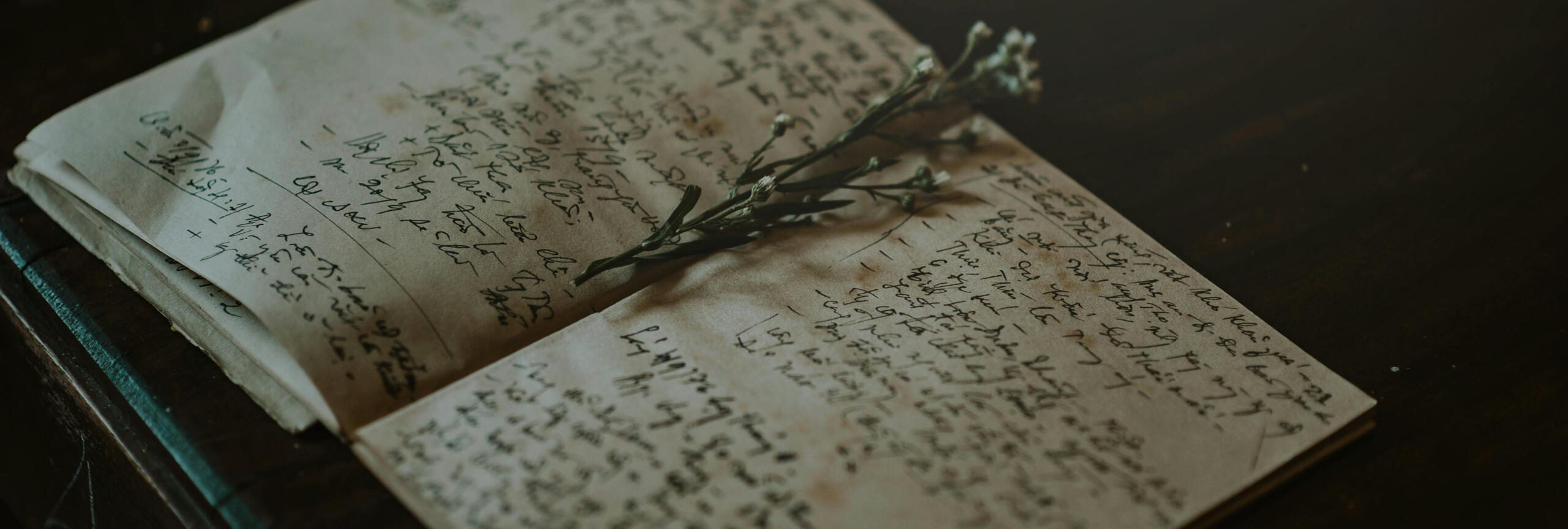
When you finish writing a piece, it can feel very tempting to go ahead and click the submission button or hit send on an email to get your work over to a publication. However, once you finish writing a piece, you still have some work to do!We have a few tips for you to increase your chances of getting accepted by a publication, in a two-part article series. The first part, which is this article, will specifically focus on editing the piece. The second one will focus on what to do while submitting your piece. Without further ado, here are a few tips for editing your piece before submitting it for publication!1. Read The Publication’s Guidelines And Follow ThemThank you for submitting to our issue. Unfortunately, due to this piece being 34 words over our guideline-specified word count, we will not be able to consider your piece.This is a situation you’d want to avoid, right?We cannot stress how important this is. Some publications have several rules when it comes to what pieces they accept, such as word limits, font size and spacing, and what type of content they can publish. Please make sure that you’re respecting the publication’s time and adhering to the guidelines that the publication has set.While many publications will likely reject your work if you don’t follow the guidelines, submitting a piece that doesn’t follow their guidelines still wastes their time - and as you’re eagerly waiting for a decision, wastes your time and hopes as well. Make sure to carefully look over each guideline and that your piece follows it.Most publications will have the guidelines somewhere on their website, social media page, or submission form. If you have trouble locating the guidelines, email the publication. If you’re planning on submitting your work to a publication, following their guideline should be one of your top priorities when creating the piece.Sometimes pieces do rely on creative elements such as spacing and formatting to enhance the meaning of the piece. If there is an aspect of your work, such as font style or word positioning, that contributes to your meaning but doesn’t seem to follow the publication’s guidelines, email them before submitting. Make sure to include a copy of your piece, the guideline that the work doesn’t follow, as well as an explanation of why keeping your work as it contributes to its overall message. They may accommodate your request.2. Read (And Reread) Your WorkHi there? Thi is the start of my storyy!!!That sentence definitely needs to be looked over.Read over what you wrote and correct any grammatical mistakes that you may have. We recommend reading your piece aloud at least once to make sure that the piece makes sense. Don’t just do a quick glance at the poem - read each and every word, and if you need to reread a certain section of the piece,do that!While you’re reading your piece and fixing grammatical errors, make sure to also look for areas where your piece could be improved. Maybe you could use a word that makes more sense in one place, or you could add a little bit more in a paragraph to paint a better picture of the setting in the reader’s mind.That being said, don’t stress over your piece too much and feel the need to read it millions of times to perfect every single little tiny detail. Each work is different, but a strategy that typically works well is to read over your piece after finishing it, read it after any major change has been made, read it one last time once everything has been changed, and look over it right before submitting the piece.We’re all human, so there may be some grammatical errors you don’t catch or a certain section you don’t spend as much time on; that’s okay. Still, make sure to look over your piece - if a publication receives a submission that’s riddled with grammatical errors or one that hasn’t been developed, they may think there wasn’t much effort put into the piece. Neither of these scenarios help with your chances of being accepted and selected for publication.3. Ask For Suggestions From Friends And FamilyHey there! I’ve written a poem recently, and I’d like for you to look over it and give me some suggestions. Thank you!Send over your work to trusted family members and friends for suggestions. Don’t have them completely rewrite the piece for you. Just ask them to give your piece a read and let you know if they have any feedback.Having other people look at your work can help provide a fresh perspective, and they may catch mistakes that you didn’t. Ultimately, it is your piece, so you don’t have to accept every suggestion that you receive. But who knows - someone may find a grammatical error or an aspect that could be more fleshed out, and your piece could end up benefiting from the changes.Here are a few other smaller tips that we have for you when it comes to editing:- Have someone else read your piece out loud to you- If you can, ask the publication for feedback and suggestions- Look over your piece over the course of a few days and not in one sitting- Do multiple rounds of editing and feedback requestingWhile following these tips doesn’t guarantee that your piece will be accepted for publication, they can help you have a more polished and refined submission overall! You can go beyond these tips as well to refine your work, such as recruiting beta readers if it’s a longer piece. Remember, every piece is different, so every process for refinement is different.We wish you the best of luck on getting published, and make sure to check out part two for tips on the submission process.
Interview with Viyomiarts

How to network with other artists / networking and build connections that will last?First, I like to go into it with the mindset that I'm not just networking for the sake of business, but because I want to make genuine connections/friends with people whose work I admire. That being said, this mindset is what helps me create lasting connections, because it doesn’t stop at just work. It might be intimidating, but sometimes just plain asking for advice on things and messaging artists who inspire you is so important and helpful! You'll realize there are a lot of people who are going through the same things. It’s really cool when they’re already an industry veteran who can give you sage advice, or someone you can bond with because they’re in the same boat as you! Join discord servers, DM artists on social media, join projects, socialize with artists under artwork posts, seek advice on stories, ask questions, even email. I would recommend Asians in Animation and The Lightbox Expo discord servers for people looking to connect with professionals.How is your experience with live streams? What do you do during them?I stream on Instagram Live just to sketch! Livestreaming on Instagram is really fun just because the majority of the people on my streams that stick around are my buddies and I can just chat and chill like I'm drawing with everyone in real life. It’s also very easy to set up. I don’t even need a professional camera. Sometimes I’ll finish existing pieces and sometimes I’ll do doodle and fanart requests.Are you looking to do collabs with other artists?I’m a little busy doing things for my part in a comic zine and school, so maybe not at this moment, but maybe in the future as time frees up!What are some things you do to keep improving your skills, what has been the most helpful?For me I like to practice a lot. Sketch every day even if it’s just doodling on the side of assignments. I think I improved the most when I was very consistent and intentional with my practice. Realizing what I struggled with and honing in on those things, as well as making sure to take breaks by drawing things I enjoyed, seriously helped me get better. Some people think that the best way to improve is just go-go-go with constant studies, but it’s also important to have fun and enjoy art, keep it balanced so you don’t burn out. What really helps me improve is by trying new things periodically. It means I don’t get stuck doing the same stuff all the time!How do you come up with ideas for your comics? (Extra Ordinary, etc…) design? Format/layout? Poses?For Extra Ordinary (comic plug!) in particular I take a bunch of stuff from my own life and random thoughts. Little things like taking the bus, eating good food, or appreciating the people around me. I think the more I look into cool things that happen in my everyday life the more ideas I have for my comics in terms of storylines and designs because they’re true to my life. They already exist. Also, I’m not a totally professional comic artist because character design’s my real niche, so I sometimes make things up on the spot when I’m making a new page. Or I’ll start with characters and make them interact, and that’s already a panel. I also browse social media and Pinterest a lot. A bunch of my mutuals make comics so sometimes I see their work and I’m like wow, that’s really cool. And maybe I’ll apply that technique they used in another way. Lastly, a lot of my ideas come from existing graphic novels. Plug: Awkward by Svetlana Chmakova is amazing and I’m so inspired by her work there.What got you into drawing in the first place?In elementary school I really honed into it with my best friend for our class newspaper at the time. We also watched so many art YouTubers (Mark Crilley, etc.) and really loved the anime drawing style, and we always inspired each other to keep drawing and making cool things.Advice for beginning artists who don’t know where to start?My advice would be to look for things you like. When you look at artwork, what catches your eye the most? What styles do you enjoy looking at the most? What stylistic choices are your favorite? What artists do you admire? You could even pull this from shows or books because a lot of beginner artists start by making fanart from somewhere. Once you know those things you can start drawing things that inspire you just to pique your interest, and study fundamentals (lighting, shadows, color theory, anatomy, perspective…) through those things. Maybe you really like a certain anime so you draw fanart that helps you practice anatomy through character posing and making portraits. The key is being inspired and enjoying it so you can improve organically. You can even do studies of other artists at first just to study their techniques. Also, please use references! Your visual library as a beginner will grow when you look at a whole bunch of things, and from there, you’ll start to get an idea of what type of work you want to make and how to work towards it.How do you make time for art?I section off at least 10 minutes daily to sketch anything. It’s an approachable time, doesn’t take up an absurd amount out of your day and you can go for more if you’d like. And even if not in that allotted 10 minutes I draw at school (on my schoolwork) so no matter how “busy” I get I can always section off time to relax after a busy day out.
Check out more of Viyomiarts' work!
Book Review: Summer in Greenland — A Lyrical Ode to Youth, First Love, and Fleeting Time
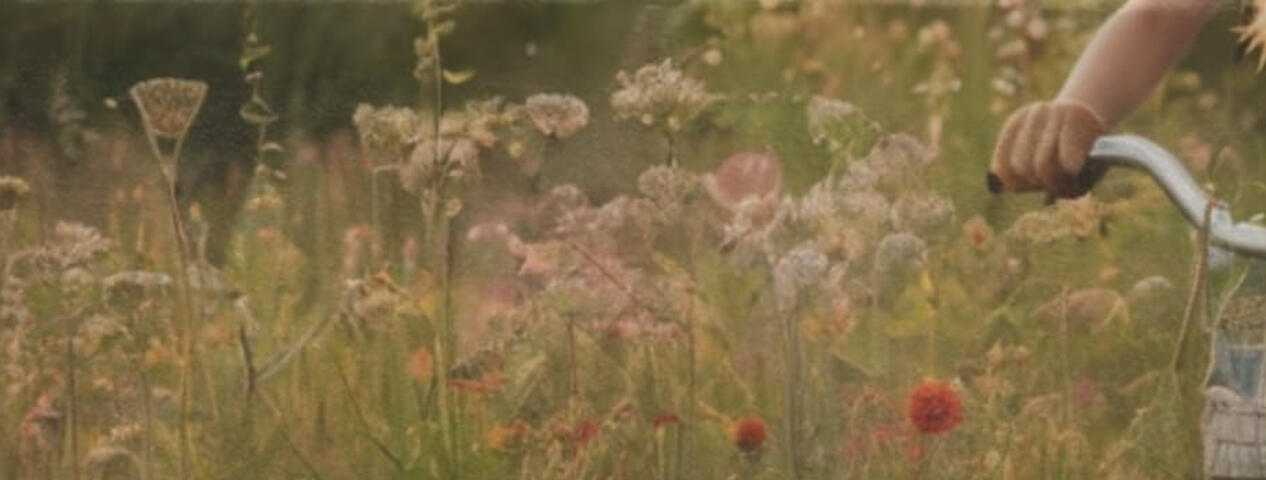
Book by: Chainka
Book Review by: LunetteSummer in Greenland has an unquestionably nostalgic and captivating quality to it, capturing the essence of growing up rather than simply chronicling a boy's summer vacation. At first sight, it appears to be a calm story about a young teen's seasonal trip, but by the end, you'll feel as if you've relived your own childhood through the warm cloud of dandelion dust and youthful idealism.Summer in Greenland is written in a poetic, stream-of-consciousness manner and follows Dean O'Brian, a thirteen-year-old kid who spends the summer in the lush countryside town of Greenland. What follows is a calm yet profound study of adolescence, identity, friendship, and first love — themes as timeless as summer itself.1. Tender Opening: Arrival in GreenlandThe novel starts with a memorable and sensory-rich introduction. Dean and his mother travel in a gray truck to the rural village of Greenland. From the beginning, the poetic text establishes the tone:“Thirteen-year-old Dean pressed his nose against the window, soaking in the vast meadows and fields scattered like toys in a child’s room.”Greenland is more than a destination; it represents freedom, adventure, and self-discovery. Dean believes it is the one place where life may be enjoyed rather than endured, free of the difficulties of maturity. The poetic comparison of trees to soldiers, and the town's environment to "gingerbread cottages," immediately ground the story in a youthful worldview that is both whimsical and wise.Even before the plot begins, the reader is engrossed in the book's style, which is defined by rich imagery and emotional depth. The narrative voice, which occasionally blends omniscient observation with Dean's own ideas, wonderfully conveys the transition from childhood to adolescent. As Dean begins to settle into the new rural life, it’s his friendships that start to shape the contours of his summer — vivid, chaotic, and full of endearment.2. Boys, Bikes, and Kingdoms: Friendship ArcEverything changes with the arrival of Lo (short for Lolita), a thirteen-year-old girl who has just returned from boarding school in England. She is immediately cast as ethereal: tall, blonde, clever, and self-possessed.
Dean is drawn to her from the moment he sees her. Their interactions are filled with intensity, curiosity, and the clumsiness of a first crush. The author does not dismiss their relationship as mere puppy love. Instead, she paints it as something monumental—world-changing in its own right.“Lo still lay on her towel, light, clear, scattered like sand beneath her, and completely intact, like the bed of the Greenland river; she was warm as summer, but rude as the wind in August when suddenly it went in and declared that soon it would be fall. Lo…”As Dean's fascination with Lo grows, the text becomes more poetic and philosophical. Dean's shared excursions — swimming in the river, riding bikes through abandoned gardens, or resting in the woods — show him wrestling with issues of love, permanence, and mortality.“Lolita released his hand, and right then, in that second, it dawned on Dean: she was the one who stole from him! And she took the most valuable thing — his heart.”That single line, given following a spectacular underwater passage, captures the quiet power of teenage love. It is transforming, complex, and strongly felt, despite lacking the vocabulary and sophistication of mature relationships. As his bond with Lo deepens, so too does Dean's growing awareness that nothing — not even the longest summer — lasts forever.4. Coming of Age and the Impact of TimeSummer in Greenland stands out for its uncompromising depiction of time's brutality. The story often reminds us—and Dean—that nothing lasts forever. Dean's journey becomes one of resisting — and eventually accepting — change, whether it's the gradual fracturing in his friend group or the creeping realization that summer is coming to an end.A critical moment occurs in the barn, when his grandfather informs him:“Raise your hand,” he ordered. Dylan obediently raised his hand to the light and, with a hint of surprise—as if seeing his own palm for the first time—examined it. “See? Look closely. Seconds are scattered in the air, and they disappear, disappear..."This beautiful depiction of time passing delivers an existential jolt. Dean recognizes that he, too, will age, that Greenland will eventually be without him, and that the people he cares about, including Lo, will change.The conflict between the permanence of place (Greenland, the river, the trees) and the impermanence of humanity becomes the dominant theme. The more Dean attempts to anchor himself in some moments, the more slippery they become. And as time keeps running, emotions get to his head — leading Dean to a moment of reckoning that will test the strength of his friendships and his courage.Final Thoughts: A Beautifully Flawed Story of YouthSummer in Greenland is unquestionably ambitious. It tries to convey the bright, disappearing spirit of childhood with literary flair. The text is reminiscent and, at times, painfully beautiful, conjuring a nearly magical nostalgia. Its strength, however, is also its greatest weakness.The language, while beautiful, can become overblown. Extended metaphors and lyrical tangents often obscure rather than clarify the emotional stakes. Some sequences, notably Dean's philosophical thoughts, are difficult for a thirteen-year-old reader to believe, blurring the line between true voice and authorial indulgence.
Furthermore, while the friendship interactions and romance are well-drawn, the pacing slows in the middle. Certain plot lines, such as May's involvement in the group or the growing conflict between Edd and Nick, feel undercooked. The novel relies more on mood than structure, and readers who like plot-driven stories may find themselves lost.Nonetheless, the emotional connection is clear. Dean's coming-of-age story — his struggle with change, love, and the dread of impermanence — lingers long after the last page. Summer in Greenland will delight readers who value mood, tone, and poetic insight over strong plotting or realism.Star Rating: ★★★★☆
Pros:
Lush, engaging prose.
Thoughtful themes include time, youth, and remembrance.
A realistic representation of first love and male friendship.
Cons:
Occasionally overwritten.
Philosophical voices may not reflect the character's age.
Underdeveloped subplots and uneven tempo.
Recommended for:
Readers aged 13 and up who enjoy character-driven storylines, such as The Catcher in the Rye, Bridge to Terabithia, and atmospheric indie films like Moonrise Kingdom.
Interview with Brianna
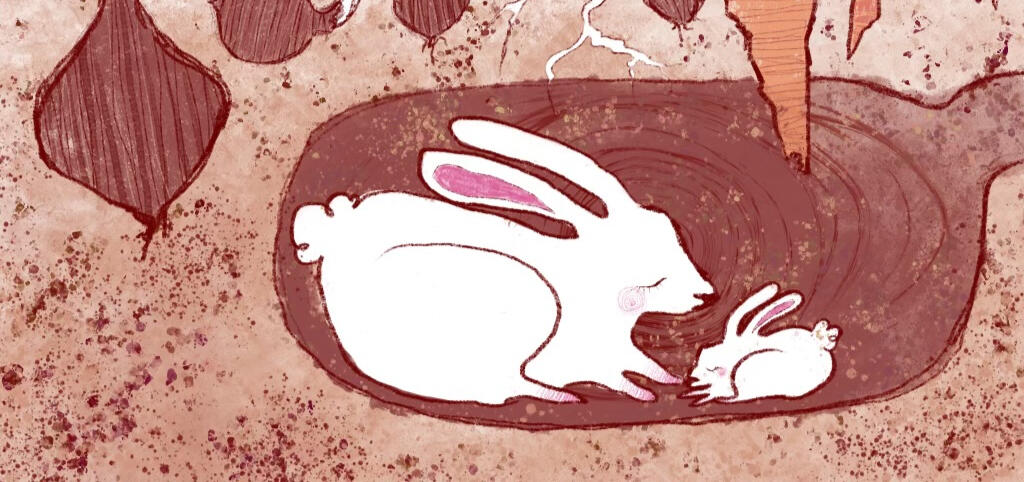
What inspired you to create “Spring is Coming?” Was there a specific moment or memory behind the concept?When I found out the prompt was like bloom, I wrote out a list of what bloom meant to me and what I wanted to incorporate into that piece. Then after I wrote out a list I made little thumbnails. I made a bunch of thumbnails and then I picked my favorite one that I wanted to show the most; I wanted to incorporate a bunny. I wanted to incorporate flowers and so I thought a fun way to do that was to have the bunnies be underground.Your use of below-ground imagery with the bunnies is so unique—what made you go in that direction?Definitely both. I wanted to kind of show a different perspective because I remember when I was in 4th or 5th grade, we learned about what a bulb was and how it could grow. And I thought that was interesting as a kid, so I kind of wanted to show how things can grow from that little ball - even if it's upside down, they still go up to rise to the surface.Was there a specific reason why you chose the different flowers and bulbs?
With the flowers, I googled what's like the most common spring flowers, and I used those.One of our other favorite parts, other than the underground imagery, was the textured like warm kind of feel of your art. In your artist statement you mentioned you wanted it to feel warm and fuzzy. Did you use any specific techniques to create that look?Well, I did it on my iPad and used certain brushes. I don't know what they're called, but I used the brushes that I thought would add a fuzzy texture,and the color palette definitely played into that aspect with, like, the calmer warm tones.There’s a sense of tenderness between the rabbits. What emotion were you hoping to share through them?I was trying to evoke a feeling of nurturing, because you can see that with the Mama Bunny and the baby Bunny. And then I also kind of wanted to show growth with the flowers, and definitely the warmth that comes with spring and comfort.Did that intention change as you were creating the piece or when you made your thumbnails? Did you know what kind of energy you wanted to bring to the piece, or did that kind of develop as you drew?I definitely knew I wanted to go in with a positive outlook; I didn’t want to focus on the negatives of spring, like, oh, it rains too much. I wanted to focus on the positives. And as I was drawing, I guess little things popped up that kind of elaborated that.What part of the piece do you like most resonate with? What was the easiest part to draw and what was the most difficult?The easiest part was probably the bunnies. I love bunnies. They're my favorite animal, so I draw them on everything. The hardest part was probably the flowers. And like how I wanted to space them out. I wanted them to all have their own spotlight and not make them too crowded.In general, how do you typically begin a new project? Do you research your subjects, and do you usually make thumbnails for whenever you're starting a new project?I always start with thumbnails. I took AP Art in high school and my art teacher kind of inspired that because the people that judge your portfolio really like seeing those, and that really stuck with me because sometimes I have too many ideas and I don't know which one to expand. So when I draw out the thumbnails, it organizes my thoughts on what elements I want to keep, what elements I want to take away, and what I want to add.I always think of an idea, and then I usually go to Pinterest and I look up reference photos and other people to see if they've done something similar to inspire me. After I gather all my reference photos, I usually draw the thumbnails Then I pick my favorite one, and then I start working on the piece. Lately, I've been doing digital pieces, but I used to do a lot of traditional pieces. So with traditional, I also had to lay out the different layers and what I wanted to start off with and layer on top of that.Is there anything that you might change in the piece if you were to revisit it?I definitely think it is very simple. I feel like I could add something, like maybe some clouds or maybe like another bunny, but, I mean, I do like how it looks, so I would keep it.How do you typically know if a piece is truly finished?I know it's finished when I feel like if I add something else, it'll take away from what I want the focus to be on, because when I was younger, I would add way too much detail to my drawings and then it would just look too busy.When you were younger and drawing more realistically, was it harder to feel like a piece was truly complete? Did you keep adding details, or were you able to let it go at a point?That's how I feel when it comes to acrylic paint. I feel like your painting can look so flat, so you just have to keep adding on to it until it's just muddy. So I definitely have that issue when I'm painting. But when I was younger, I drew a lot of dress designs; I wanted to be a fashionista, so I would draw outfits. They would be so elaborate and detailed and not realistic at all, but that was my goal. I wanted to be, like, out of this world.Has art always been your passion? When you were like fashion designing, was that because you like to draw the designs or was that because you like to create the designs?Art's always been a part of my world. My aunt is an artist. My older sister is an artist. So I have artists in my family and my family and always have liked art as a kid. When I was drawing those dresses as a kid, I definitely liked the part where I could draw the girl and style her hair, but I also liked that I could make her wear whatever I want.Do you often work with themes of growth and seasons, or does it depend on the moment?When I was in high school, I took AP Art, and for that you would have to find a theme for your portfolio. My first theme was fantasy because I was really into the fantasy folk art aspect. I also wanted to be an illustrator, so I thought that would be connected to my career path. Then my senior year, I took AP Art again, and I wanted to focus on family and nostalgia because, I was growing up, I was finishing high school, and I was thinking a lot about when I was a kid. I wanted to connect that to my senior year, because when you're senior, you feel very nostalgic because everything feels like it's ending.But now, I’m not really taking any art classes, so I kind of just draw what inspires me, like my pets and things I find in my backyard. Just what I see in my everyday life.You said you wanted to be an illustrator. Do you still want to be an illustrator, or what's your goal with art?I actually want to be an art teacher. I teach art to elementary students once a week, and I really enjoy it, so I want to start teaching high school art. My AP Art teacher was amazing. I loved her and I think about her all the time, and she definitely actually didn’t encourage me to be an art teacher, because it’s a hard career. She said, “you don't want to do it,” but I was like “I do want to do it,” and now I'm teaching these elementary kids and I have so much fun planning the little little projects for them and trying to incorporate, like lessons of shapes and contrasts. I really enjoy it.Are you working on any other projects, big or small, with art?Right now I'm just doing some stuff for fun. I'm going to paint a picture of my boyfriend’s dog for his birthday because she's really cute, and I think that would be fun. I'm also working on another piece I've been working on for a while just because I've kind of been procrastinating, but it's going to be a picture of my living room from when I was like a kid. And then on the couch are going to be all the pets that I had in my lifetime; so it's going to be my dog and all of my cats, and they're all gonna be like cuddling together on this big couch.Do you have anything else you want people to know about you as an artist?
I don't just do art. I also sell and I have a little Etsy shop selling customized clothes - a little fun fact about me.Anything else like in general about you about art or anything?I think art is a great way to express yourself and everyone should take one art class in their lifetime.Do you have any advice for artists just starting off, or anyone currently experiencing a lack of ideas or motivation?Practice really, really helps. I remember one summer, I bought this giant new sketchbook and every day I would take like 30 minutes to draw, and it definitely did help me improve. I know it sounds so annoying to sit down and be like practicing every day, but it does help and it really does help you find your style and what you like to draw.
Brianna's piece Spring is Coming was a notable artwork from iSSUE VI.
WIFTY (Rang Rang)
By: Isabelle

“Before I met you, I only lived to keep the name, Zhang Lurang alive, but after meeting you, I was excited for tomorrow to come” -Zhang Lurang. When I Fly Towards You (WIFTY), released in 2023, took the storm of the C-drama industry. The show, starring Zhang Miaoli as Su Zaizai and Zhou Yiran as Zhang Lurang (Rangrang), received overwhelming love from c-drama fans, wave to earth fans, and romance antiques alike. The show follows Su Zaizai’s high school life as she finds her first love, Zhang Lurang to her high school graduation, and eventually her marriage with Zhang Lurang.Though WIFTY is one of my favorite shows, it’s undeniable that the show is filled with cringy scenes and minimal plot movement every episode. However, the cute scenes between Rangrang and Zaizai as well as the development of the character Rang Rang itself makes the show worth watching.The show first introduced Rangrang as a quiet, distant, introverted, boy who’s often found buried in a book, studying. Despite being cold and distant, he’s found being the topic of conversation for many of his classmates as a result of his good looks and high grades.Su Zaizai, however, is the complete opposite of who Rangrang is, as she’s extroverted, cheerful, and optimistic. The difference between the personalities of Zaizai and Rangrang, drew them closer together and allowed the watcher to better understand Rangrang’s complex family dynamics and the impacts it has on Rangrang.Rangrang’s Family Dynamics
In Rangrang’s family, he’s the eldest of two, having a younger brother, Luli who lives with his parents while Rangrang stays at his uncle’s house to be closer to his school. However, during the New Years, Rangrang’s family came to celebrate the holidays with him. During the holiday season, we could see that Rangrang’s younger brother was adored by the whole family as he excelled in school and was even able to skip a grade because of this. As a result, his parents viewed Luli as a perfect child who never does anything wrong or causes any worries. On the other hand, Rangrang, despite scoring the highest grades in all the subjects except English, his mom would often criticize him for not being as smart as his younger brother and not studying more, causing more problems for the family.In the later scenes, we see Rangrang in his room studying, refusing to move on to the next question until he understood it. Additionally, when his friends asked him to hang out, he turned down their request simply so he would be able to study. Through all the hard work, his achievements were never recognized by his parents since Luli was always able to do better than him.During the New Year dinner with his parents, his mom made sure that she had all the foods that Luli enjoys and that he didn’t have to eat the foods that he didn’t like. However, when it came to Rangrang, she didn’t even know that he was allergic to shrimp, symbolizing the fact that he’s simply ignored in his household because he wasn’t able to meet their expectations.This results in him isolating himself from the world and reviewing class material, in order to meet his parents’ standards.Additionally, in one episode, Luli suggested that they play video games together as he hasn't been able to pass the level by himself. Despite Luli was the one to suggest playing video games, when his parents saw that Luli and Rangrang was gaming, they immediately assumed that Rangrang was the one who forced his younger brother to start gaming as a way to “erode” his brain, claiming that back home, Luli never played video games.The constant toxicity towards Rangrang pushed Luli to leave home later that night, believing that his parents were only toxic to Rangrang because of him, so if he was to disappear, they would no longer be this toxic to Rangrang. Even though a son disappeared in the middle of the night in an unfamiliar city, his parents' first reaction was to blame Rangrang for not being more careful, resulting in the disappearance of Luli instead of brainstorming where Luli could be.How This Impacts His Relationship With Su ZaizaiAs seen throughout the show, Rangrang was never appreciated or understood in his family. This was reflected in his love for Su Zaizai as he always made sure that she felt seen and appreciated whether that’s buying her favorite foods, learning her hobbies, or simply listening to her struggles.Although he wasn’t interested in Zaizai at first, her carefree and naïve personality that resembles his golden retriever created a sort of bond between the two. They got even closer after Zaizai was assigned to be Rangrang’s English tutor while Rangrang tutored her in maths and sciences. At first, they were just classmates teaching each other but the longer they spent together, the stronger their feelings were for each other. Their relationship blossomed after the grades for the tests they help each other study for got released.When Rangrang saw that Zaizai was able to improve her grade, rather than thinking that he was a great tutor, he brought Zaizai some snacks, symbolizing that he recognized the hard work that she put in to improve her grade, which was something he was never recognized for.Similarly, when Zaizai saw that Rangrang was able to improve his English skills, she brought a stuffed animal that had a recording of her voice, congratulating him on his success. Throughout the show, whenever Rangrang would feel discouraged or stressed, he would always play the recording as it reassured him that there’s someone who believes in him and is proud of him.Though Rangrang was never a talkative kind and would often seem cold or distant when Zaizai talks to him, he would always listen and remember things that Zaizai told him. For instance, when Zaizai realized that Rangrang was feeling down one day, she handed him pudding saying that whenever she felt down, she would just take a bite of the pudding, to raise her mood. After hearing that, Rangrang would make sure that he had some pudding in hand so that when Zaizai was ever feeling down, he would be able to cheer her up.
This form of affection towards Zaizai was established because he wants her to know that she’s heard and important to him.
Another example would be during Zaizai’s first business trip. The business partner was making her feel uncomfortable and when she stood up for herself, her co-workers all sided with the partner in order to not lose the sponsorship. As a result, she left the conference and waited outside the room for the conference to finish. While she was waiting, Rangrang called her to make sure she’s okay and everything is going smoothly. Upon hearing her voice, Rangrang immediately picked up that something bad happened to Zaizai that she’s not sharing. Therefore, Rangrang decided to drive 3 hours to pick Zaizai up late at night, just so she wouldn’t be by herself.Finally, towards the show’s finale, Rangrang pulls Zaizai into an empty room that will later be the apartment they share together. There, he would propose to Zaizai while a vlog he compiled of their high school years and all the little moments they shared together played in the background as he knew that vlogging was something Zaizai really valued.ConclusionOverall, Zu Yiran did an incredible job in portraying Rangrang and bringing the character to life. Despite the show being a slow burn, the producers were able to incorporate how living in a toxic family affected who Rangrang is as a person and ultimately how he treated Zaizai. Since Rangrang rarely felt valued or recognized in his household, it resulted in those being his priorities when it came to being in a relationship with Zaizai.
Princess Mononoke Movie Review
By: Anya
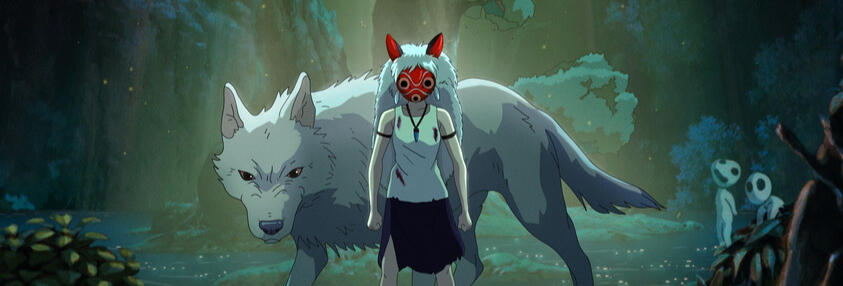
Princess Mononoke is a Japanese animated historical fantasy film by Studio Ghibli that explores the importance of nature, and the dangers of hatred. Set in a mythical past, the story follows Ashitaka, a young Emishi prince cursed by a demon, who seeks a cure and becomes caught in a violent conflict between Irontown; a small industrial town, and the forest gods.
At first, it seems to be a typical man versus nature story, however, this movie takes a neutral stance. Miyazaki presents themes of environmentalism and industrialism, without demonizing one side or the other. Lady Eboshi, leader of Irontown, is responsible for the destruction of the forest, yet she is also a progressive figure who provides refuge and purpose for lepers and former brothel workers. On the other side, San is a human girl raised by wolves and taught to protect the forest and hate humans. Ashitaka explores both sides of the conflict, witnessing how hatred and violence have corrupted both sides. Miyazaki also portrays San and Lady Eboshi as strong, empowered women. San is an independent and fierce warrior, yet compassionate toward the forest and Ashitaka. Lady Eboshi leads Irontown with authority and empathy, offering refuge to lepers and former brothel workers. The women of Irontown play a central role in iron production and are respected and praised by Eboshi, creating a matriarchal and supportive community of women.
Although the romantic relationship between Ashitaka and San felt a little underdeveloped because their emotional bond progressed too quickly with minimal interaction, I think the film focuses more on their mutual understanding and recognition of each other’s values. They see and respect each other despite coming from different sides of conflict. Ashitaka sees San’s pain and her loyalty to the forest. San, in turn, sees Ashitaka’s effort to understand both the forest and Irontown without judgment, and they support each other’s growth.
In conclusion, Ashitaka serves as a crucial bridge between Irontown and the forest, embodying the possibility of understanding one another in a conflict. Rather than choosing a side, he seeks to see the good and the flaws in both. Princess Mononoke, teaches that in times of division, we should not be blinded by hatred or consumed by violence. Instead, we should strive to listen, understand, and find common ground, only then can we begin to heal and rebuild a world where both nature and humanity can coexist.
Threshold
By: Vanessa S.
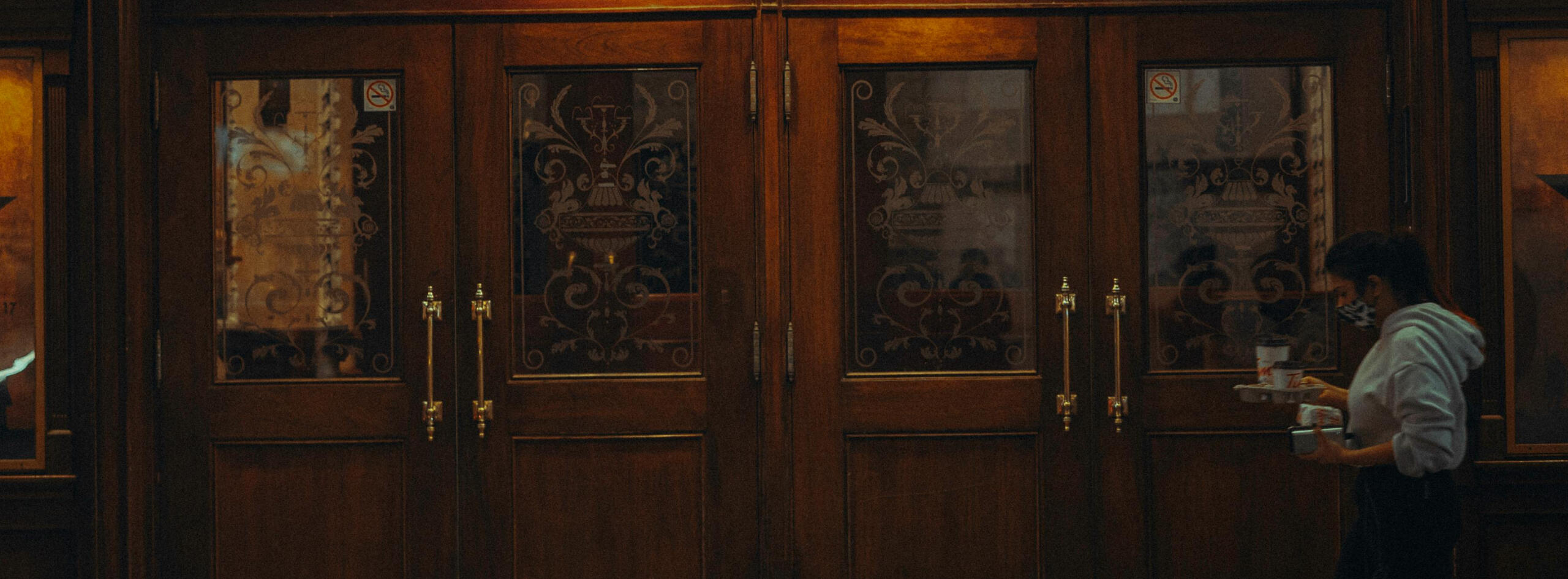
Threshold
The air is thick with dying gold,
the trees like specters bow and weep.
A hush, a hush, the branches moan,
as autumn lulls the world to sleep.The doors creak, creak! A hollow throat
the echoes whisper, whisper names.
I step inside! Yet all I was,
will never walk this hall the same.For time is but a fickle hand,
a ghost that tap, tap, taps the pane.
It steals the voice, it dims the eyes,
it sings of loss in soft refrain.Oh, tell me, must I follow through?
Must I become what waits ahead?
The past still rustles in my bones!
Though all its echoes now have fled…yet, tick, tick, tick! The hours call!
As seasons turn and worlds expand.
For what is change but fate’s decree,
a map unfurled by unseen hands?And so I step! The hush returns!
The wind exhales, the shadows lean!
The walls inhale a different name,
as something shifts! Unheard and unseen!
Fate
By: Diana
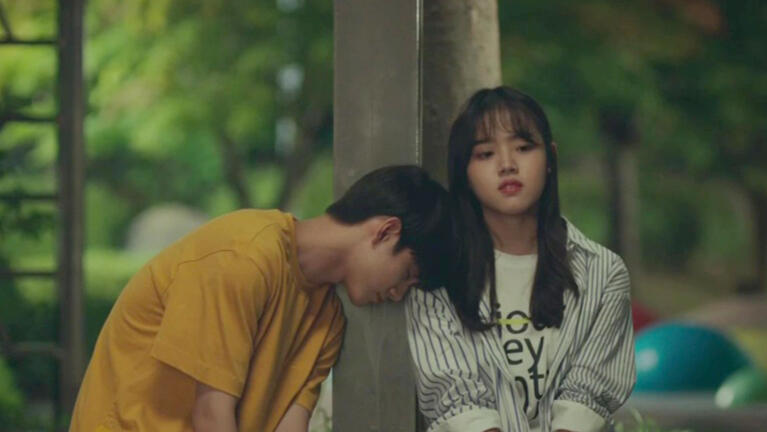
How can a lover feel like a stranger
We’re so close yet it feels like
An ocean is between usWho’s that?
NobodyYet we know each other’s
Biggest fears, dreams, loves,
It’s nobody but
We have each other as our lock screen
We see each other in every corner we turn
We’re each other’s last thoughts every nightAre we nobody because of our stories?You get the top grades at our school
And I’m just barely passing
You come home to chandeliers and crystal floors
And I come home to old lamps and wooden floors that creak
You spend your afternoons at cram schools
And I spend mine working at a convenience store
Your parents got into Seoul national university
And my mom only graduated high schoolMaybe it’s the differences that drive us closer together
After all, doesn’t opposite attract?If so, why does the universe seem to be against usMaybe in another life
You can trust me more than a text meant to ruin our relationshipI’m sorry I didn’t do better
Sorry for not reaching out
For not noticing
Why do we have to hide from the world?Can’t they just accept the fact that we’re more than just classmates?And see you more than just a “forced transfer troublemaker”
Cause you’re so much more than thatYou bring the class together in times of chaos
Your ideas make the high school life memorable
Your ideas bring in new perspectives
And most importantly
You make high school much more than just studyingI’m sorry I didn’t see that sooner
That all those actions weren’t just a façadeI’m sorry that deep down, I still see you as a troublemaker
That it led me to trust a text meant to sabotage our relationship
More than your wordsI’m sorry that it didn’t work out.
I’m sorry I’m the way I am
I hope we can love each other again
~ love you <3
Winter Book Recommendations
By: Gina

It’s that time of the year again when we all snuggle up in our cozy blankets, drink hot chocolate, and wait for the soft snowflakes to land. However, there is no true winter without books! Where are some of our favorite winter stories to snuggle up with and escape this winter, as the world grows dark.Number 1: Lovely War
Age range: young adultA beautiful historical fiction romance written by Julie Berry, the Printz award-winning author of The Passion of Dolssa, this book combines the elements of Greek mythology with the true events of the first world war. Lovely War is one of the most unique crossover books I’ve ever read.The story starts off with Hephaestus, the Greek god of craftsmanship, catches his wife Aphrodite cheating on him with Ares. In the original Greek myth, Aphrodite, the goddess of beauty, was forced into an arranged marriage with Hephaestus because Zeus, the King of Gods, feared that the other male gods would fight over her. One day, Hephaestus caught Aphrodite and Ares together with an indestructible and invisible net. He refused to let them go unless Aphrodite agreed to a divorce.In Lovely War, Hephaestus demands there to be a court case to hold Aphrodite guilty for infidelity, but Aphrodite instead wishes there to be a private case, so she can defend herself as her husband acts as the judge. She claims she is lonely and unloved, presenting her case by providing evidence of mortal love stories. I was enamored with Aphrodite’s reasoning for the love between her and Ares, and how love is basically two sides of the same coin.Lovely War is not just a warm and romantic story. It spins the tragedy of heartache and torment. It tells the story of how, with war, a gruesome, chaotic, and brutal reality can coexist with love— a tender feeling, an unbreakable bond, a neverlasting reverie.Number 2: The False Prince
Age range: 13 and aboveThe False Prince by Jennifer Nielsen is the first book of the Ascendance Series. The book takes place in an unstable kingdom fueled with civil wars. To unify the kingdom, Bevin Conner, a nobleman of the court, sets out to find a teenage boy to impersonate the long- lost prince Jaron. There, Connor meets the main character, Sage, a fourteen-year old orphan who makes a living by stealing food from others. Sage, along with two other boys named Roden and Tobias, are all brought into Connor’s grandiose mansion to begin their training, but only one will become the false prince.What I love about the book is that the situation is not what it seems like. Sage himself is not just any random orphan boy. Sage also knows the treacherous nature of Connor, and throughout the story, he vows to figure out the truth behind Connor’s intentions and history.The False Prince is one of my favorite fantasy books because the lore is very well-written and intricate. The political tensions, sword fighting, and training the boys have to go through to impersonate a prince is beyond fascinating. Overally, the book is a must read for anybody who enjoys a good medieval fantasy drama.Number 3: Red Queen
Age range: young adultRed Queen is a YA dystopian fantasy novel written by Victoria Aveyard that dives into the themes of power imbalances, oppression, and social class. In the kingdom of Norta, humans are divided and classified by their blood type: either silver or red. Those with silver blood are wealthier, god-like, and privileged, contrasting the red-blooded people, who struggle with poverty and who work as servants beneath the silver-blooded people.We get introduced to the protagonist, Mare Barrow, a red-blooded girl whose siblings were all drafted in the war due to being Reds. The Silvers use Reds as human fuel to keep their war going, and despite having enough money to treat their injuries, the silver would rather hoard their wealth than to assist the reds. Everything changes when Mare is tasked to act as a royal servant at an event called Queenstrial, where noblewomen compete for the marriage with the two princes.Throughout the story, Mare struggles with trust, for the people she meets always have another secret side to them. Although the story is obviously fictional, I like how Red Queen tackles many issues that apply to the real world today, like how those in power have the opportunity to create equality but refuse due to greed. Red Queen is an amazing book for people who want to dive into the themes of social inequality and oppression.Number 4: Narnia: The lion, the Witch, and the Wardrobe
Age range: 10 and olderThe Lion, the Witch, and the Wardrobe is a classic enjoyed by those of all ages. As a kid, this was my favorite Narnia book of all time. It’s filled with magical elements, such as talking animals, portals to another land, and adventures through a fantasy world.The story is about four siblings: Peter, Susan, Edmund, and Lucy. The four siblings are sent to live with a professor whose mansion is home to a magical wardrobe. Lucy is the first sibling to discover this. As she hides in the wardrobe, she lands in a snowy biome. According to the faun she meets, Narnia has been enchanted by the evil White Witch so that there is eternal winter.I personally liked the metaphors being the plot choices. The danger of gluttony is presented in Edmund’s trust in the white witch and his cravings for Turkish delights. The simple trope of Good vs. Evil is turned into a fantasy adventure where the four children are tasked into fighting the oppressive leader of Narnia as heroes. The story is a timeless classic where all of our childish imaginations come to life.Number 5: The Nightingale and the Rose
Age range: 10 and olderThis one is a way shorter story. It’s by the famous author Oscar Wilde, and it is awfully tragic. I actually cried when reading this as a kid.Unlike most stories, which paint love in a wholesome light, The Nightingale and the Rose shows how greed, deceit, and apathy, can be mistaken as love. Love itself brings great sorrows because with love comes trust and vulnerability, and those things can be easily taken advantage of.The story surrounds a boy who wishes to go to a dance with his crush, but his crush demands red roses, which he does not have. A nightingale witnesses this and wishes to make the lover story come true. The bird flies through the garden, searching for a red rose…but can she find one on time?The story illustrates how love is not always a happily ever after;, rather, it can lead to great heartache and pain. If you’re into stories that don’t have a simple resolution, this could be your next favorite read.So, grab a blanket, make yourself a cup of hot chocolate, and let these stories transport you to places where magic and adventure runs deep. Winter may be old but with the right book in your hand, your heart will stay warm. Hopefully you like my recommendations!
Interview with Mehul Chowdhary
What inspired you to create Through Dragon Gate?In elementary school, I used to be into legends. I came across the legend of the dragon, the Chinese legend and how the car jumped through the water, falling into the gate; for me at the time, it was really cool because I hadn't ever read something like this. Then, when I looked back at it in high school, I realized that I could use it to represent how people can overcome their hardships. And it was the only creative idea I had at the time, so I just decided to try it.Was there any specific moment that inspired you to create it? Did you have to do any research before you got into creating it?Yeah, I did research what Chinese Dragons looked like because I didn't know how to draw them. And, I also had to research how the fish looks like itself and the colors used to make it.Do you typically plan like your art as much as you did this one?Yeah. I spend a while sketching and then go over it again on paper. Then, I take a photo of it and retrace it again on my iPad, and then I start coloring it.How did you decide on the color? Was it just what the dragon and the fish were supposed to look like, or did you try to make them cohesive in any way?For this fish, I actually didn't know what to do at all, so I searched up a palette and then modified it a bit to make it a bit cooler. For the dragon, I tried to use the dark clone on the fish and make it that the basin said to show contrast with the white fish. For the other colors, I basically just played with them until I found something I liked.How do you usually do backgrounds? Do you put a lot of thought into it?I'm not too good at backgrounds. But if you see other digital pieces, they have these really intricate backgrounds, so I tried my best to not make it too simple. I also couldn't make it too much because I don't know how to, so I mostly just used gradients and there's just reflection tool in procreate which kind of reflects the subject and adds some noise and distortion, and I use that to make it a bit more detailed.How long did it take you to complete the work? And how long does it typically take you to, like, think that a piece is completely done?It took me six hours to make this one, and I would say that's a little a little shorter than the ones I spend a lot of time on. The longest one I did took me like 10 hours, but that's only because I redrew it again and again and again until I was satisfied with it. Around 3 hours is what I usually do. Then, if I want to put extra effort, it goes up to 10 hours.How do you know when a piece is complete?When I think that I cannot add anything else to it that will make it significantly better. For example, you know how people add these little effects once they're done? Once I realize that won't truly help it too much, it's fine as it is. I guess that's what I know when it's done.Did the meaning behind the piece change while you were drawing it?In the first sketch I drew, the fish was supposed to be small, and it was going to be more of a large dragon and a physical gate instead. I decided to change that so the fish wouldn't be as insignificant as it was in the first sketch. I also removed the physical dragon gate because I felt like drawing it symbolically made more sense in this case.What meaning do you hope that viewers take away from the piece?That they can understand that there's no specific restriction on how a person has to be in order to change for the better of course. And if this fish can do it, then I think you could do it too if you try.If you could revisit the piece and add anything to it, would you add anything to it?Yes, I think I would enhance the wispy lines a bit more so it's clear to see, and maybe make the background just a bit more detailed. Other than that, nothing else.When did you start drawing and when did you realize that it was something that you love to do? Was it a moment in time, or was it just gradual?It was more gradual. I started a long time ago, when I think it was when I was five or six, but that was just like more of, you know, young kids doodling. I started to draw more in middle school, and that's when I started to do it more consistently. But nowadays I've started to decrease my time because of homework.Do you have any like advice for artists that are starting off, or any advice for anyone who might be struggling with artist block?Don't try to force yourself to do something. A lot of times, I don't have any ideas, and if I just try to force myself to make something, it doesn't really work. If you're struggling with ideas, maybe search for inspiration online or just look at everyday things around you and draw them. You know you might find something new that you like drawing. Mehul Chowdhary's piece Through the Dragon's Gate was a notable artwork from iSSUE V.
Interview with Chainka
What inspired you to create “the portrait of a girl in the apple garden?”It's hard to pick just one thing. I was actually thinking about The Portrait of Dorian Gray, the book which I read a long time ago. This piece is kind of dedicated to my friend, but also to me in some ways, and all the girls that have been through it because, you know, we never know what will be in adulthood. And we always wait for something beautiful to happen. But I think, in the moment, it was the book and just the understanding of growing up.How does the piece reflect your own life experiences?I'm from Ukraine, so I've been through the war and, in parts, I still am. And while I was growing up, I always felt like a kid in a glass house, in that I've been always been protected, almost even overprotected by my parents because they didn't let me see anything bad. I always thought I was safe.Then the war hit, and I felt like I was on my own. And the realization that this is it, this is how adulthood looks. I think from that perspective, it was also about the dialogue between me and my younger self.How do you typically begin a new piece? Do you do any research for it, or do you just start writing?It depends on what kind of piece I'm writing, because sometimes I just have this idea of something and I start to write. But then sometimes I have a more profound piece. I remember writing, for example, a poem called “The Russian Mother,” and it was about Russia and the history of Russia. I really wanted to make it deep, with a lot of metaphors, but I didn’t want to overdo it.For this particular piece, for example, I dug, but I think writing is such a unique process for everyone. Somebody might take one minute to create something and it will be perfect. And someone else has to really think it over, and I think that's okay.How do you know when a piece is ready to be published, or if it's perfect?Honestly, I always ask myself, ‘is it really that good or do I just like this at this particular moment?’ But I think that the best part of writing is that you never have a perfect finished piece; I sometimes come back to the poems that I wrote a long time ago and wonder, ‘can I add something here?’ and ‘I like this one more now.’I think we, as writers, sometimes create fences with the idea that we should add only this and we should take this as a finished result, but it's fun to mess around to make more interesting notes to add something.So, for me, I think I never know if the piece is perfect. If it touches my soul, I like it. It could be very badly written, especially with misspellings, but if it touches my soul, I'm good with it.How long did it take you to complete “the portrait of a girl in the apple garden?” Did your vision for the piece evolve as you worked?If I'm not mistaken, it took me one evening. I was just sitting with my parents and we were watching some kind of movie, and I just had this idea of the girl standing in the garden. I was like, ‘I have to write it right now or otherwise I'll forget about this, like I always do.’ So, I just started writing on a piece of paper and I think a lot of pieces were lost in process because I just couldn't understand what I wrote.But I wrote it one evening, and then the next morning, I was rereading it to my friend, and I think that the next morning I didn't add anything. I feel like maybe I've added some things as I was submitting it, but that was kind of it.If you could revisit the piece, do you think you would change anything?I don't really want to come back to the piece because I think it was really good. I think even if it has some weird aspects, I just want to leave it like this to interpretation for everybody. I don't want to change that, at least for now, for the record.What else do you want people to know about you or about your piece?I really hope that my art touches someone deeply and heals them. I don't mean healing like making them instantly feel good, but I just want them to feel like, ‘wow, somebody knows me,’ because when I started writing at the time of the war, I just felt very depressed. I was in a new place that I didn't know, and I didn't want to explore.I just started writing, and I felt like there were pieces of me that really understood the other, smaller me. And I just want the same for everybody. I want them to read my poetry or prose and feel like there's a reason for living and to keep going.I feel like the most important thing to know about me is that I'm just a human. I don't want to put any labels on myself, like I’m an artist or whatever. I feel every person is an artist, and can learn or at least try art.Do you have any advice for people who are just starting off with art or just starting off with writing?You have to start somewhere. There's always this fear that is holding you back, but you will feel it every time. Every day in our life, there's something that we fear doing. There is alwaysfear in our life, but fear is not bad. You just have to keep going, and, even if somebody thinks your art is bad, it's okay.I don't feel like an artist should be understood. We try to understand everybody, but that doesn't mean that we will be understood. Some art is alluring, but we still can't find answers to why, for example, this writer wrote this line or why this painter made his painting like this. I think art is all about moving you. You have to start somewhere, and you will always find people who will support you; if nobody supports you, I support you. Somewhere on this earth, I’m here for you.
Chainka's piece the portrait of a girl in the apple garden was a notable poem from iSSUE V.
Percy Jackson TV Show Review
By: Zara Azeem
Rating: 4/5The new Percy Jackson and the Olympians series on Disney+ is the newest adaptation of the beloved Percy Jackson and the Olympians book series. So far, only one season depicting the first book has been released. Will the series live up to the fans’ standards of the original series, or will it fail like the myriad of previous adaptations before it?The story follows Percy Jackson, a young 12-year-old demigod, on his journey to discover who he is while simultaneously exploring the world of Greek mythology. The son of the god Poseidon and a mortal, Sally Jackson, he joins his newfound friends, Annabeth and Grover, on a quest to solve the mystery of who stole Zeus’ lightning bolt. If he fails, war will break out.So, you know, pretty low stakes.In the TV show adaptation, Walker Scobell, Leah Jefferies, and Aryan Simhadri play Percy, Annabeth, and Grover, respectively. As some fans have labeled it, they seem to have “fallen out of the book”. This is largely due to Rick Riordan’s involvement in casting: of course, he knows who best represents the characters that he himself created.Indeed, Scobell, Jefferies, and Simhadri have truly captured the personality of their characters. However, we can’t ignore the fact that they are simply kids. Their acting, especially at the show’s beginning, wasn’t representing their full potential. At times, their bland reactions and emotions minimized the excitement of the scene. Nonetheless, they still made the show enjoyable through their accurate depiction. We can trust that they will improve and grow as the series progresses.The show portrays one book, Percy Jackson: The Lightning Thief, in only 8 episodes. Despite this, many parts of the show feel dragged on longer than needed. For example, when Percy and Grover travel to Hades or when Percy and Annabeth discuss Hephaestus’ trick when entering the amusement park, the scenes are long and unimportant to the plot, adding just about zero entertainment value.Still, almost all episodes were able to create an exciting atmosphere through the action-packed scenes. But that brings up another technical issue: confusion. I had read the books beforehand, so I had a basic understanding of most of the context. However, the show might seem random for people who haven’t read them because some parts are not explained enough. On that note, I truly missed Percy’s internal dialogue and narration while watching the series. His sassy remarks and his perspective were the most entertaining parts of the book.Yet, other aspects of the show were able to get me hooked. The sets and some scenes in the series were exactly what I imagined. Camp Halfblood is exactly what I pictured when reading the first book. The natural beauty surrounding the camp and Percy’s cabin especially caught my eye. The Greek architecture is magnificent and adds to the magical aspect of the series. I found the first interaction between Annabeth and Percy during Capture the Flag so accurate, summarizing their relationship perfectly.Making film adaptations for the books has been attempted before; case in point, Logan Lerman’s infamous interpretation of them. They ultimately failed and never made it past two films. Riordan himself was not fond of the films, and neither was I. The gross inaccuracies that were presented and the over-aged cast were not something I was hoping for in the show’s adaptation. And thankfully, history did not repeat itself on these insufficiencies.The casting directors of the new Percy Jackson series decided that Logan Lerman would not play Poseidon, Percy’s father, despite anticipation from fans. They chose to keep the two adaptations separate from each other, which, in my opinion, was the better choice. The Percy Jackson TV adaptation needed to start fresh and proved to be more accurate and enjoyable for younger viewers, which is the target audience.Overall, if you are looking for a family-friendly TV show, the new series is perfect for you. If you have read Percy Jackson's books previously, watching the show will surely make you want to read the books all over again, for the loveable characters, friendships, and Greek magic and myths. But if poor pacing and acting get on your nerves, you might want to sit out this season. You’ll definitely want to stay tuned for future seasons, though, which hopefully will improve. I think I speak for most people when I say that despite the downfalls of the first season of Percy Jackson, I’m impatiently waiting to see how Riordan portrays the next books on our TV screens!
Book Review: Addie Larue
By: Sneha Moudgalya
4.5 stars.For someone who’s been alive for over two centuries, Addie LaRue doesn’t have many friends.
In fact, there isn’t anyone who remembers her, really. Addie has stumbled through almost 300 years of life with no one to talk to, or rely on, with her biggest goal being to leave a mark on the world; but it never really works. That is, until a boy recognizes her at a tiny bookstore, opening a whole new chapter in her dazzling adventure.The Invisible Life of Addie LaRue by V. E. Schwab (or just Addie LaRue for short) is a book of mystery, romance, and adventure, shifting back and forth through historical and present narrative to slowly bring Addie’s situation to life. It’s exactly the type of slow-burning mystery that mesmerizes me; but in particular, the book stuck with me for two main reasons.
First, the writer’s style, which can really make or break a book. I’ve read some reviews heavily criticizing Schwab’s dynamic structure throughout the novel, but the choice made sense to me with the plot that she was crafting. To be less vague about it, her style is a mixture between prose and poetry, the latter of which only appears at the most crucial points in the story. It helps to foreshadow what’s to come, and establishes the poetic passages as turning points in the book. It was also an interesting artistic choice, making the book a lot more memorable.
Now, let’s talk pacing. Like I mentioned above, the story switches regularly from historical to modern time periods, giving the novel a puzzle-like feel. Throughout the book, we follow Addie’s adventures, both in the past and present, which Schwab deliberately links to eventually reveal the events that placed her into her situation. The unhurried exposition was the main thing which kept me hooked, from cover to cover.The second choice I liked in Addie LaRue was the ending. Everything Schwab mentions in the book seems to serve a larger purpose, and there are probably numerous easter eggs I missed in my first read-through which hint towards the story’s resolution. I promise you, no matter how much of a book detective you take yourself for, you will not see the end coming; but it all makes sense.If there’s one thing about me, it’s that I love when an ending circles back to the beginning, wrapping everything like a present—I mean, who doesn’t? Well, this book does exactly that. I could go on and on and on about the end because as soon as I finished the book, I knew how hard it would be to find another ending to top it; but, I digress. Read the book, and you’ll see what I mean.Now that I’ve talked about all the things I love about Addie LaRue, there is one small detail that holds it back from five stars: the romance. Don’t get me wrong, I’m a sucker for a good romance. In fact, I might even say it’s my favorite genre. But the romance in this book just felt a bit forced. Like, there’s only one person who remembers her, so she falls in love with him? If it was a different guy with a completely different personality, would she fall in love with him too? The progression was just a little too quick for my liking. Then again, the love story is just a side note to Addie’s greater adventure, so it’s not the biggest critique – just a picky detail, more of personal preference. It would take a lot to overshadow the effect the ending had on me, though.
For anyone looking for the perfect mystery adventure, this one’s for you. It’ll be pretty hard to put down, I promise you that. It has a bit of mythology and romance mixed into it, enhancing the magic the book makes you feel, but mainly follows one girl through centuries of trying to make her mark on the world who can’t seem to remember her; and somehow, in the end, she manages to do just that.
Internships for Students
10 activities. All 10 of them should be related to your ”intended major” while at the same time showing you have “passions.” College applications have been getting more competitive by the year.Several activities, like internships, can help you fill those 10 spaces. However, can they fulfill you and provide an enjoyable and worthwhile experience? Now, that’s something to ask yourself.You might struggle with finding unique extracurriculars that you enjoy doing and, at the same time, provide you with proper work experience. For example, you could be a prospective journalist who interns with a local newspaper office, but if your only job is filling out paperwork, that doesn’t fulfill your desire to write and share your voice with the public.NAi, a student-led lit magazine, is a platform for student creativity. We publish a wide range of student work, from paintings and photography to poems and stories. Recently, NAi has evolved into an independent organization, and we're expanding our team. This is your chance to lead, propose new ideas, and actively participate in the new and improved NAi. Internship applications are now open, allowing you to make a real impact as a student.NAi has something for everyone, with departments for social media, finance management, editing, writing, and website design.Our social media team advertises our issues and creates short-form content to expand our reach and recruit more members. Reaching a larger audience requires extensive strategic planning.One wildcard position we have is financial management. As a part of this team, you have the chance to manage our new non-profit structure, fundraising, and budgeting. If you want to explore a career in business management, this position is perfect for you!Editors view our submissions and explain to the editorial board whether to reject or accept submissions. They also provide feedback to contributors.Our graphic design team leads the creation of the issue's spreads. If you enjoy art and design, this is something to consider.Website designers play a large part in maintaining our brand and visibility. As a part of this department, you would help create and update our website and ensure high SEO stats. This is an excellent opportunity if you’re considering a career in Computer Science or Web Development.An exciting part of NAi is our blog about media, books, movies, and more! If you’d love to contribute, apply to be a writer. You'll have a significant role in choosing how we connect with other youth on our website.NAi is a place of growth and opportunity. We have internships available for all students, offering the chance to boost your college applications and gain valuable experience. More than that, being part of our team can provide a sense of fulfillment and enjoyment as you pursue your passions.Apply now to be a part of our team and grow with NAi! Your future career starts here.
Young Writers – an interview with Apuroopa Kavikondala
By: Catherine Xue
Learn more about this exciting young writer and her work!I. IntroductionRecently, I’ve had the honor of interviewing Apuroopa Kavikondala, a published teen author and a passionate advocate for mental health.For those unfamiliar with Apuroopa, she is a junior in high school that has published four books, one of her most recent releases being Us AF, a story which follows three main protagonists as they navigate the final years of their high school life. Outside of being a published author, she’s a dancer, martial artist and a social animal that aspires to make an impact and highlight the gravity of mental health.In this interview, I was able to ask her a few questions about her general publishing/writing process, as well as more focused questions on Us AF. Read more here.















